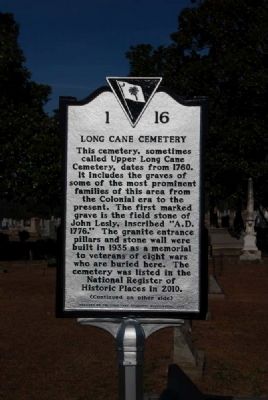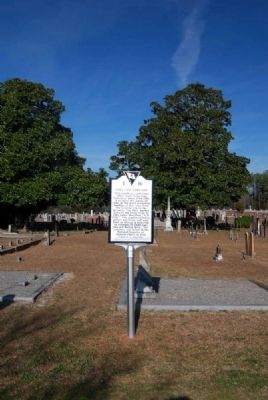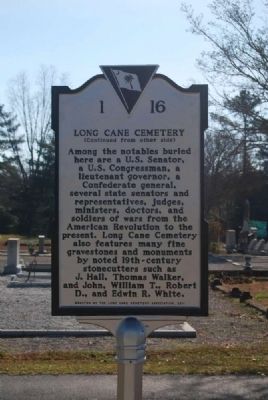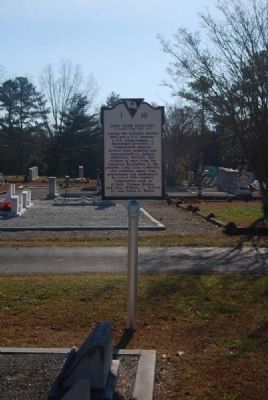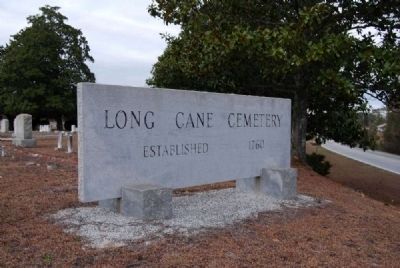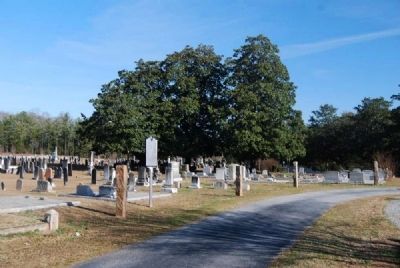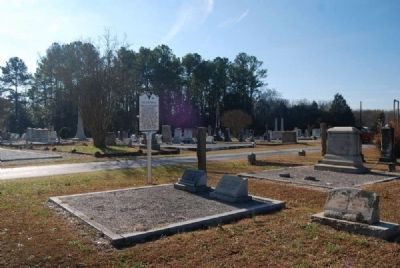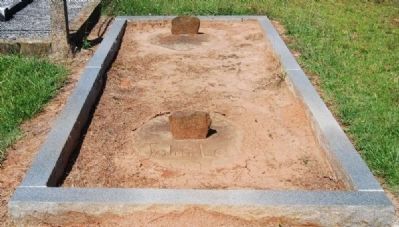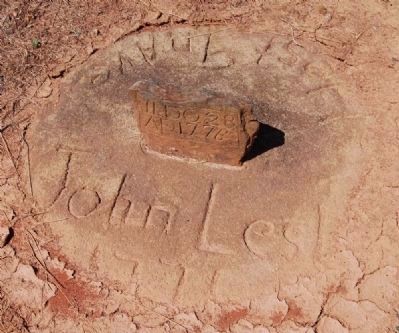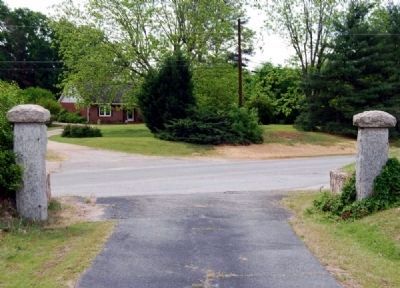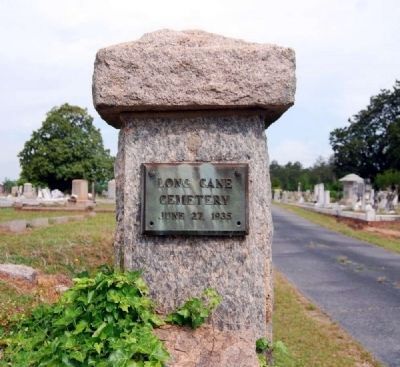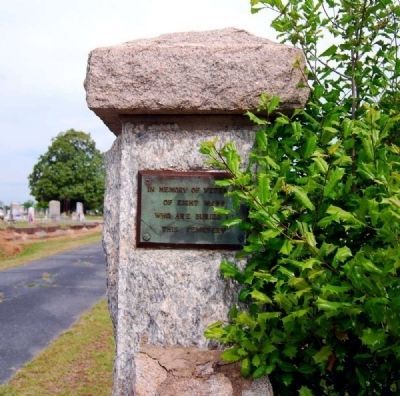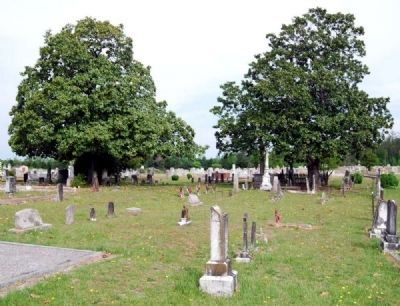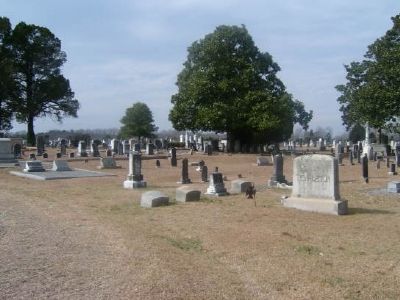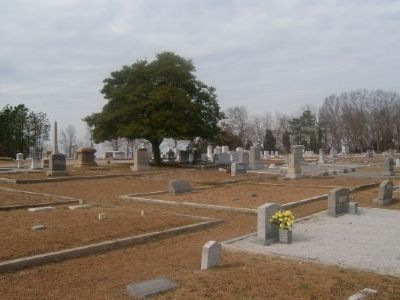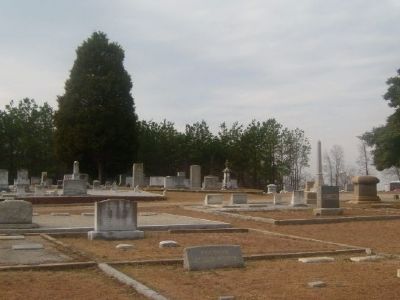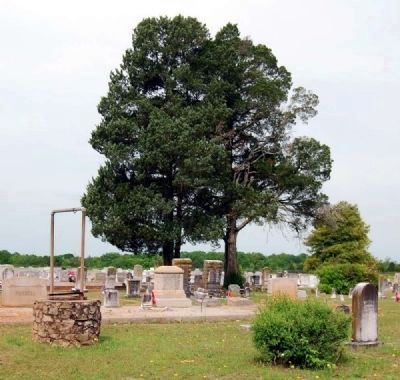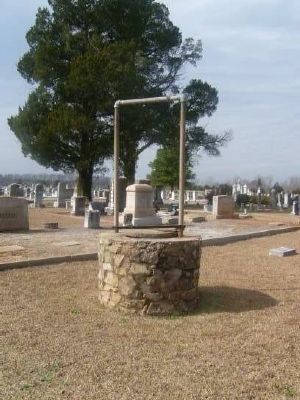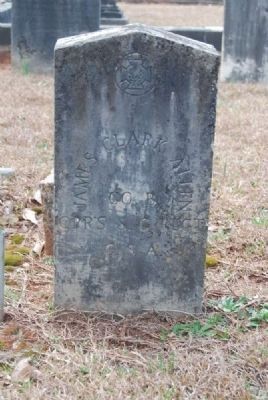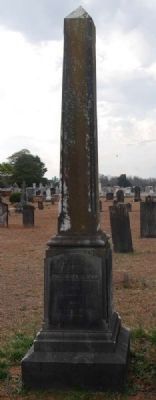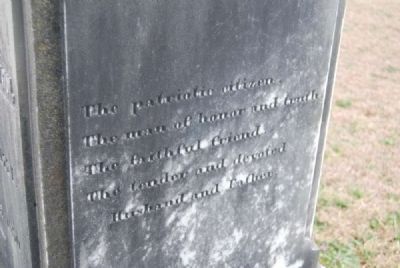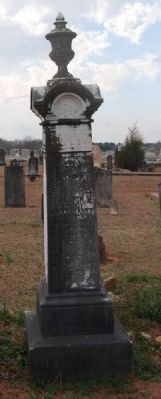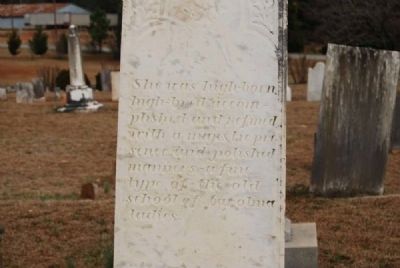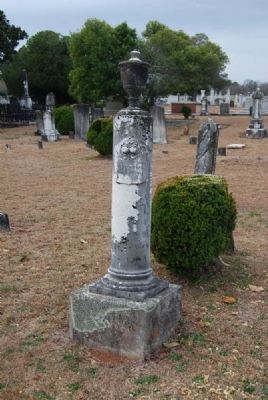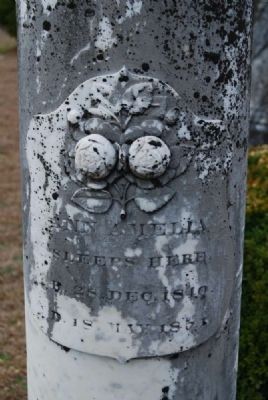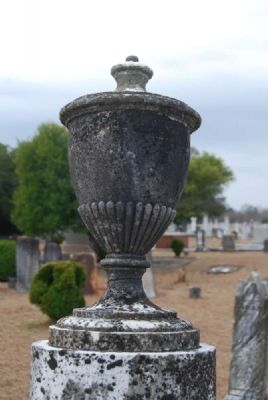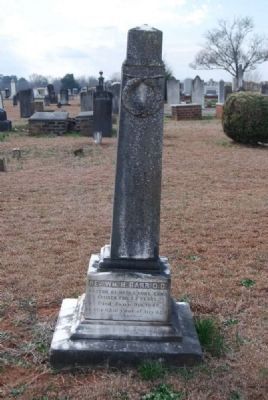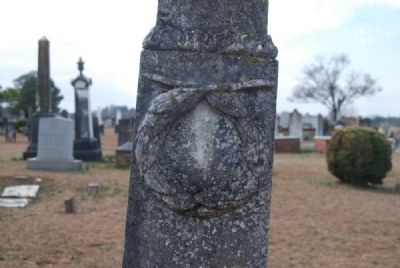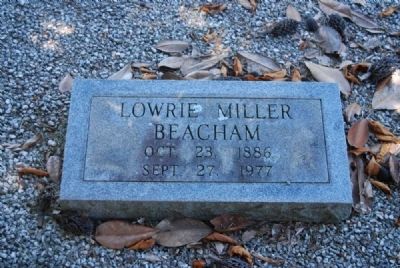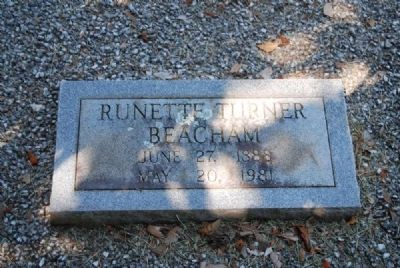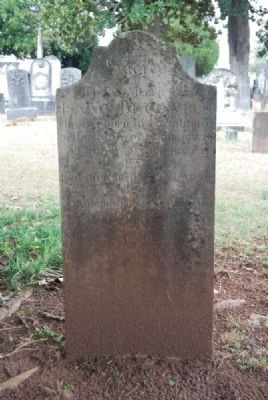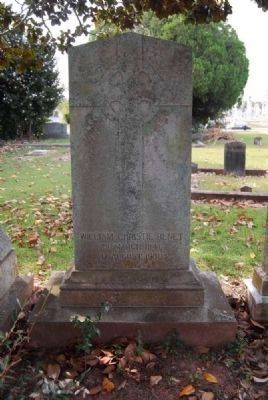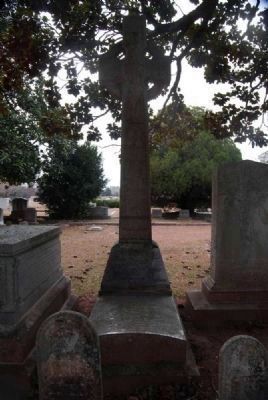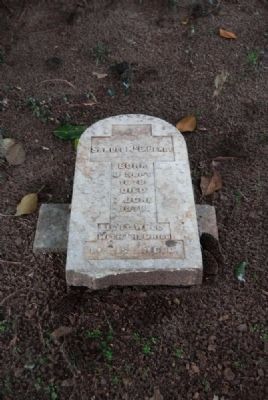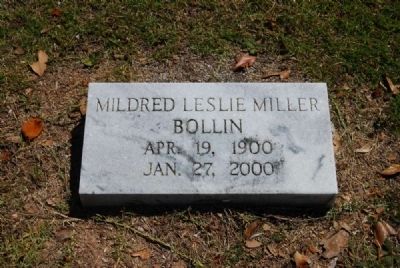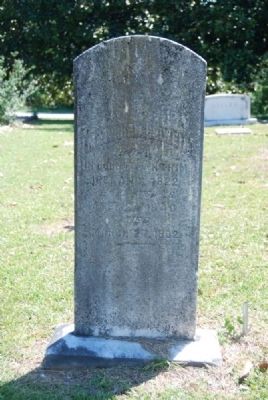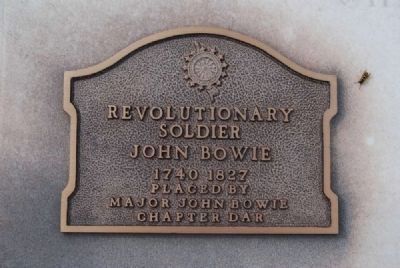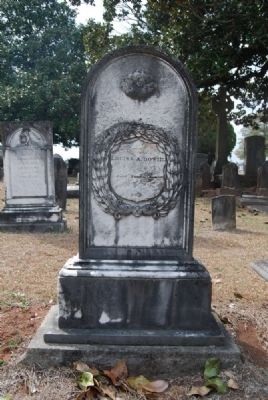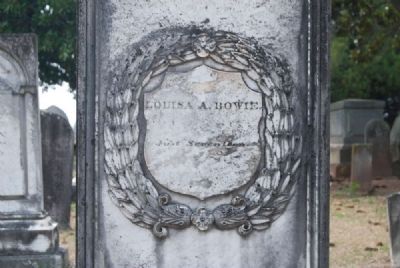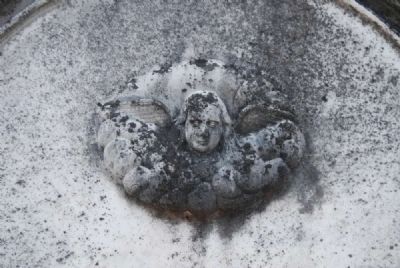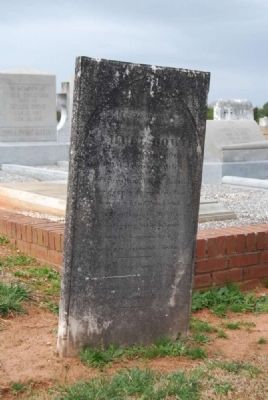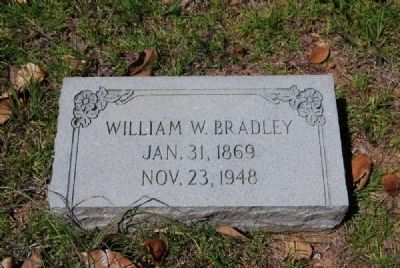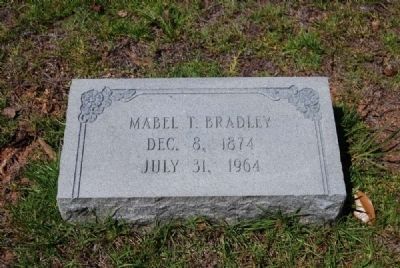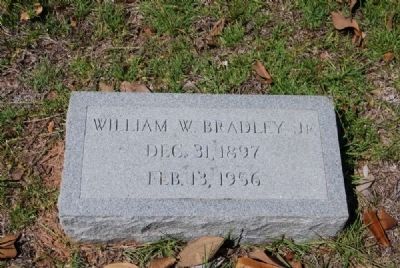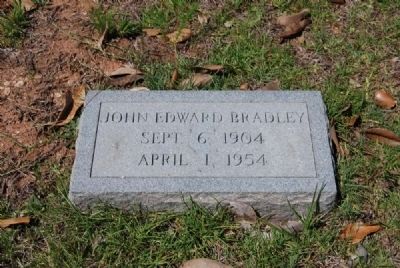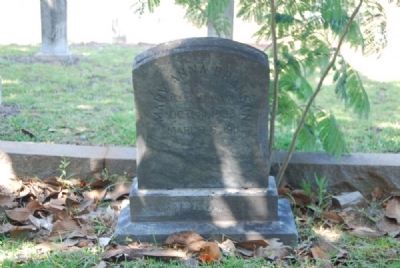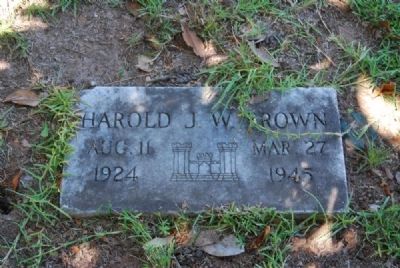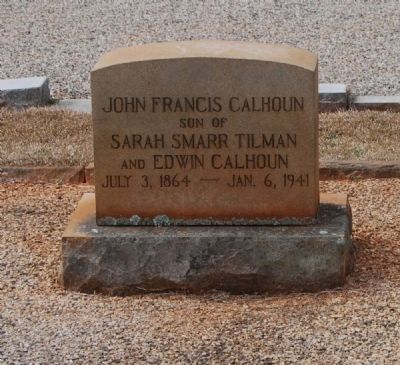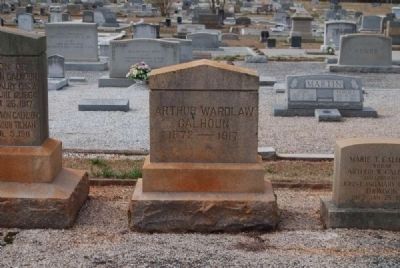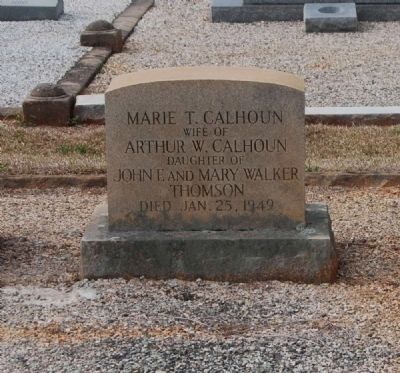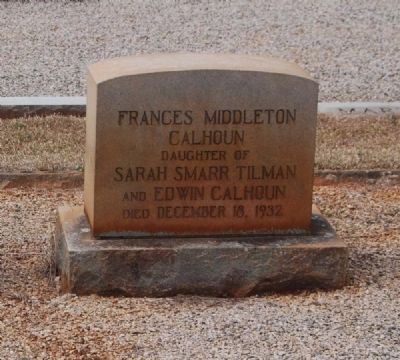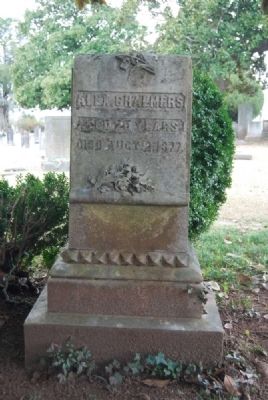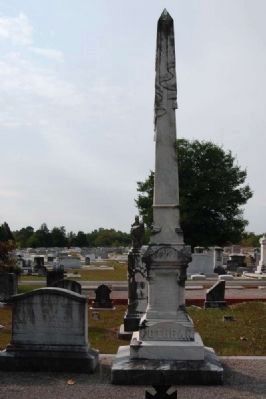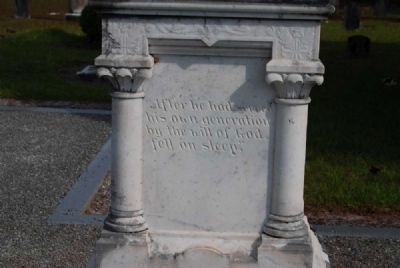Abbeville in Abbeville County, South Carolina — The American South (South Atlantic)
Long Cane Cemetery
[Front]:
This cemetery, sometimes called Upper Long Cane Cemetery, dates from 1760. It includes the graves of some of the most prominent families of this area from the Colonial era to the present. The first marked grave is the field stone of John Lesly, inscribed "A.D. 1776." The granite entrance pillars and stone wall were built in 1935 as a memorial to veterans of eight wars who are buried here. The cemetery was listed in the National Register of Historic Places in 2010.
[Reverse]:
Among the notables buried here are a U.S. Senator, a U.S. Congressman, a lieutenant governor, a Confederate general, several state senators and representatives, judges, ministers, doctors, and soldiers of wars from the American Revolution to the present. Long Cane Cemetery also features many fine gravestones and monuments by noted 19th-century stonecutters such as J. Hall, Thomas Walker, and John, William T., Robert D., and Edwin R. White.
Erected 2011 by Long Cane Cemetery Association. (Marker Number 1-16.)
Topics and series. This historical marker is listed in this topic list: Cemeteries & Burial Sites. In addition, it is included in the Daughters of the American Revolution series list. A significant historical year for this entry is 1760.
Location. 34° 12.217′ N, 82° 23.417′ W. Marker is in Abbeville, South Carolina, in Abbeville County. Marker is on Greenville Street (State Highway 20) near Beltline Road (County Road S-1-35). Touch for map. Marker is in this post office area: Abbeville SC 29620, United States of America. Touch for directions.
Other nearby markers. At least 10 other markers are within 2 miles of this marker, measured as the crow flies. First Burial in Long Cane Cemetery (within shouting distance of this marker); Harbison College President's Home (approx. 0.8 miles away); Thomas Chiles Perrin House (approx. 1.6 miles away); Abbeville's Confederate Colonels (approx. 1.6 miles away); Burt-Stark House / Jefferson Davis’s Flight (approx. 1.7 miles away); The Last Meeting of the Confederate States Cabinet (approx. 1.7 miles away); McGowan-Barksdale-Bundy House (approx. 1.7 miles away); Colonial Block House/Fort Pickens (approx. 1.7 miles away); Fort Pickens (approx. 1.7 miles away); Maj. Thomas D. Howie (approx. 1.8 miles away). Touch for a list and map of all markers in Abbeville.
Also see . . .
1. Upper Long Cane Cemetery. Upper Long Cane Cemetery, established ca. 1760, is significant as the first cemetery in the vicinity of Abbeville, for its association with the settlement, early growth, and development of Abbeville and Abbeville District, and for its association with prominent area families and individuals of the late eighteenth century through the first half of the twentieth century, including numerous persons important to the city, county, state, and nation. (Submitted on December 19, 2011, by Brian Scott of Anderson, South Carolina.)
2. Find-a-Grave: Long Cane Cemetery. Highway Bypass 28 and Greenville Street, Abbeville, Abbeville County, South Carolina. (Submitted on December 20, 2011, by Brian Scott of Anderson, South Carolina.)
Additional commentary.
1. Upper Long Cane Cemetery - National Register Nomination Form (2010)
Upper Long Cane Cemetery, sometimes called Long Cane Cemetery and occasionally mistakenly called Upper Long Cane Presbyterian Church Cemetery, is located just north of the junction of Greenville Street (S.C. Highway 20) and Beltline Road (S.C. Secondary Road 1-35), approximately two miles north of Abbeville, in Abbeville County, South Carolina. It is bordered by Greenville Street to the east, Beltline Road to the south, and a chain-link fence to the north; there is no formal boundary on the west. The cemetery is approximately twenty-five acres (24.69 acres) in size, and is subdivided into three sections, further subdivided into ten units. This late eighteenth to early twenty-first century cemetery maintains an unusually high degree of integrity of location, design, setting, materials, workmanship, feeling, and association.
Narrative Description
The main entrance to Upper Long Cane Cemetery, at the junction of Greenville Street and Beltline Road, is flanked by two granite pillars 6’ high, with attached sloped stone walls that rise from ground level to a height of approximately 4’ feet where they meet the face of each pillar. Bronze plaques are mounted on each pillar, reading “Long Cane Cemetery / June 27, 1935” on the left (west) pillar and “In Memory of Veterans / of Eight Wars / Who are Buried in / this Cemetery” on the right (east) pillar. A 3’x10’ granite marker erected in 1963, just south and east of the right (east) pillar and wall, reads “Long Cane Cemetery / Established 1760.”
The cemetery, though near the city limits of Abbeville, is in a rural setting with a gently-sloped footprint, with roads to the east and south, woods to the north, and an open field to the west. There is no real formal landscaping; the “Old Section” (Section 1) includes several mature magnolias, a few deciduous trees, boxwoods, and other bushes.
It contains more than 2,500 marked graves, many of them in family plots or sections, and an unknown number of unmarked graves, on approximately twenty-five acres.[1] Most grave markers, carved from marble, granite, sandstone, or slate, are headstones (some with footstones), although there are also numerous obelisks, pedestal-tombs topped with urns or crosses, box tombs, table-top tombs, tablets, and other markers of varying materials and shapes. Funerary art ranges from simple engraved tombs, tablets, ledgers, and monoliths to more ornate draped tablets, obelisks, columns, or shafts, with ornaments including such motifs as angels, doves or lambs, open Bibles, weeping willows or palmettos, and flowers, wreaths, and ivy.
Upper Long Cane Cemetery includes more than fifty gravemarkers “signed” with the stonecutters’ names on them or attributable by style to particular carvers and their shops, most notably those carved by prominent Charleston, South Carolina, stonecutters Rowe and White (the partnership of James Rowe and John White, active ca. 1819-1825), John White (active ca. 1822-ca. 1850), William T. White (active ca. 1850-ca. 1870), Robert D. White (active ca. 1855-ca. 1875), and Edwin R. White (active ca. 1860-ca. 1882). Other signed stones, all from the nineteenth century, are marked “Boyle,” “J.D. Chalmers,” “J. Hall,” and “Sproul, and “Walker’s.”
Particularly notable examples of gravestone art include these stones (in chronological order):
William Langdon Bowie (1827-1851), a marble tablet [broken and lying on the ground] with a round quirked-bead arch, its tympanum featuring a detailed wreath of laurel and oak leaves in relief. This stone is signed “W.T. White.”
Eliza Thomson (1822-1852), a marble tablet with a pointed arch, its tympanum featuring an elaborate draped sarcophagus in relief, with a wreath and clasped hands. This stone can be attributed by lettering style, carving detail, and date to William T. White. This tablet and the tablet of Alexander McDuffie Reid (q.v.) are the only gravestones this author has seen to date that depict a sarcophagus—that is, a representation of a tomb, a significantly more elaborate means of burial, on a tablet—in any South Carolina cemetery.
Lt. Frederick William Selleck (1824-1853), a rectangular four-sided tapered marble shaft with a pointed arch, featuring an American flag and the inscription “To the memory / of the / Hero of / Garita de Belen.” It was commissioned by his former company commander, Capt. Jehu Foster Marshall, commander of the “McDuffie Guards” of the Palmetto Regiment during the Mexican War.
Rebecca Gordon (1777-1854), a marble tablet with a round quirked-bead arch with pendants, featuring a raised shield, against a delicately-tooled surround. This stone can be attributed by lettering style and date to William T., Robert D., or Edwin R. White.
Alexander McDuffie Reid (1830-1855), a marble tablet with a round arch with molded surround, its tympanum featuring an elaborate sarcophagus in relief, surmounted by an eagle with an olive branch in its left talon and a drapery in its right, leaning down and devouring a serpent. This stone can be attributed by lettering style, carving detail, and date to William T. White. This tablet and the tablet of Eliza Thomson (q.v.) are the only gravestones this author has seen to date that depict a sarcophagus—that is, a representation of a tomb, a significantly more elaborate means of burial, on a tablet—in any South Carolina cemetery.
Samuel Reid (1788-1857), a marble tablet featuring a pedimented arch with key resting on engaged Ionic columns, and a seated angel in relief leaning against a funerary urn with her right arm draped over it, her head resting against the lid, and her left hand at the base of the urn holding a wreath. This stone can be attributed by callligraphy style, carving detail, and date to William T. White.
James Witherspoon Wardlaw (1840-1860), a marble tablet with a Gothic pointed quirked-bead arch featuring a cinquefoil tracery, with the inscription reading, in part, “At the time of his death / A Member of the Senior Class / in South Carolina College. / Refined in his Manners, / Delicate in his Feelings, / Tender in his Sympathies, / Scrupulously exact from his very / Boyhood in his whole demeanor / A devoted Son, an affectionate Brother / And a generous Friend. / ” This stone can be attributed by lettering style, carving detail, and date to William T., Robert D., or Edwin R. White.
Pvt. William Henry Perrin (1833-1862), a marble tablet with a Gothic pointed quirked-bead arch, featuring a shield with the inscription “fell in Battle at Gaines’ / Mill near Richmond Va. / June 27th 1862. / The bravest are the tenderest.” This stone can be attributed by lettering style, carving detail, and date to William T., Robert D., or Edwin R. White.
Pvt. Robert Henry Wardlaw (1840-1862), a marble tablet with a coved bevel round arch and the inscription “He received his last wound / on the lines near / Petersburg Va. 31 March 1865 / After much suffering he / reached home and Died 5 / May 1865. / A soldier of Christ and / of his country.” This stone can be attributed by lettering style and date to William T., Robert D., or Edwin R. White.
Col. James Monroe Perrin (1822-1863), a four-sided marble shaft with a pointed-arch top, featuring a bouquet of roses in relief, dominated by a large rose at the center, and the inscription “Mortally wounded / at the battle of / Chancellorsville, Va. / May 3, 1863. / Died the following / morning.” This stone can be attributed by lettering style, carving detail, and date to William T., Robert D., or Edwin R. White.
Pvt. Thomas Samuel Perrin (1841-1863), a marble tablet with a Gothic pointed quirked-bead arch, featuring a shield cartouche. This stone can be attributed by lettering style, carving detail, and date to William T., Robert D., or Edwin R. White.
Pvt. James Samuel Willson (1841-1863), a marble tablet with a pointed arch, its tympanum featuring a detailed palmetto tree in relief—the emblem of the state of South Carolina—and below the tympanum the inscription “When the war commenced for Southern / rights and independence he was a student at Erskine / College a member of the junior class / and although of slender and delicate frame he / hesitated not when his country was in danger. / In Feb. 1861 he volunteered & united with Comy. B / 7th S.C. Regt. with whom he remained up to Feb. / 1862 when he was severly attacked with Rhumatism. / In April he was discharged and sent home on crutches. / In Oct’r. he united with the Presb’n Church at Long Cane / and in March 1863 when only partially recovered from his / rhumatic affection with weak and stiffend joints he again / returned to the service of his country, united with Comy. G / Orr’s Regiment and on Sunday the 3rd of May 1863 while
/ in the charge at Chancellorsville Va. he fell pierced in the / left breast with a minnie ball and died without a struggle. / He is not lost but gone before / The resurrection of the just will unfold his character” This stone can be attributed by lettering style, carving detail, and date to William T., Robert D., or Edwin R. White.
Capt. William Henry White (1836-1862), a marble pedestal-tomb with an octagonal shaft with each facet teminating in a semi-circular arch, featuring shield cartouches on its pedestal faces, with the inscription on the front shield “killed on the battlefield / of Second Manassas / August 30, 1862.“, the inscription on the left shield “To surviving friends and / kindred is left this / germ of comfort— / that amid the battles / fiercest shock he fell / nobly discharging / his duty, and died full / of faith in God and a / glorious immortality.”, and a blank shield cartouche placed at the vertical center of its frontmost facet. This stone can be attributed by lettering style, carving detail, and date to William T., Robert D., or Edwin R. White.
Sgt. Lewis Alfred Wardlaw (1844-1865), a marble tablet with a beveled edge and curvilinear cap, with the inscription “Died at home / June 6, 1863 / from wound received at the battle / of Chancellorsville Va. / A gallant Soldier, a noble boy.”
Capt. George Allen Wardlaw (1837-1865), a marble tablet with a Gothic pointed quirked-bead arch with the inscription “Graduated So. Ca. College 1857. / Admitted to the Bar 1859. / Entered Confederate Army 1861. / Captured near Richmond Va. / July 28, 1864. / Long a prisoner in Fort Delaware. / Broken by exposure & hardships / He returned home to die.” This stone can be attributed by lettering style, carving detail, and date to William T., Robert D., or Edwin R. White.
Pvt. Robert Henry Wardlaw, Jr. (1840-1865), a marble tablet with a round coved arch. This stone can be attributed by lettering style, carving detail, and date to William T., Robert D., or Edwin R. White.
Mary Frances Sondley (1833-1872), a marble tablet with a round quirked-bead arch and tassel pendants. This stone can be attributed by lettering style, carving detail, and date to Robert D. or Edwin R. White.
Judge David Lewis Wardlaw (1799-1873), a marble pedestal-tomb with a four-sided base, featuring an octagonal tapered shaft with a round-pointed tip; the pedestal features cartouches, and is topped by broken scrolled pediments joined with acroteria on its four faces; the shaft features an intricate swag drapery pinned with rosettes between its cincture moldings, and a blank shield cartouche placed at the vertical center of its frontmost facet. This stone
can be attributed by lettering style, carving detail, and date to Robert D. or Edwin R. White.
Thomas Chiles Perrin (1805-1878), a marble pedestal-tomb featuring a column covered by a drapery with tassels, with round-arched cartouches on its pedestal. This stone can be attributed by lettering style, carving detail, and date to Robert D. or Edwin R. White.
Thomas Thomson (1813-1881), a marble pedestal-tomb surmounted by a funerary urn atop a closed book, featuring a bouquet and an intricate drapery with fringe and tassels. This stone can be attributed by lettering style, carving detail, and date to Edwin R. White.
Significance
The Upper Long Cane Cemetery is eligible for listing in the National Register of Historic Places at the state level of significance under Criterion A in the Area of Significance for Social History as the first cemetery in the vicinity of Abbeville, established ca. 1760; for its association with the settlement, early growth, and development of Abbeville and Abbeville District (later Abbeville County), and for its association with prominent area families and individuals of the late eighteenth century through the first half of the twentieth century, including numerous persons important to the city, county, state, and nation. It is also eligible for listing at the state level of significance under Criterion
C in the Area of Significance for Art for its concentration of outstanding gravestone art by master Charleston, South Carolina, stonecarvers William T. White (active ca. 1850-ca. 1870), Robert D. White (active ca. 1855-ca. 1875), and Edwin R. White (active ca. 1860-ca. 1882), skilled artisans who were part of a three-generation lineage of outstanding sculptors in nineteenth century South Carolina belonging to the Walker and White families.
Social History
This cemetery, the earliest in what was the Ninety-Six District in 1784 and Abbeville District after 1785, then Abbeville County after 1868, contains the graves of the most prominent families and individuals of the area from before the American Revolution to the mid-twentieth century, and as such conveys the settlement, early growth, development, and significance of the town of Abbeville and of Abbeville District/Abbeville County, and the region along the Savannah River and the Georgia-South Carolina border as well, for more than two hundred years. Few cemeteries—if any—in South Carolina can rival Upper Long Cane Cemetery for its association with, and ability to convey, the history of a town, its county, its region, for such a long period.
The first known burial in Upper Long Cane Cemetery dates to ca. 1760, and is of an unknown person associated with the family of John Lesly (d. 1776). Tradition holds that a young girl, either a relative or a visitor, died at Lesly’s house after being badly burned while making lye soap, and that John and his brother Thomas (d. 1778), who lived a short distance apart in the vicinity, walked to a point halfway between their homes and buried the young girl here, establishing a family cemetery where John and Thomas Lesly were later buried. The first marked gravestone in the cemetery is that of John Lesly, a field stone with the inscription “J.L. D. O. 28/ A.D. 1776.” [John Lesly Died October 28/ A.D. 1776.][5]
Though sometimes called Upper Long Cane Presbyterian Church Cemetery, this cemetery predates the 1763 establishment of Upper Long Cane Presbyterian Church. In 1793, not long after the American Revolution, the Upper Long Cane Society was organized “to provide a permanent fund for the support of their congregation, for endowing one or more schools for orphans and poor children to be taught free of expense, and for other benevolent purposes.”[6] Incorporated in 1799, the Society is still in existence.
In 1935, after years of relative neglect, the Long Cane Cemetery Society cleaned up the cemetery and built a large stone wall with flanking granite pillars and bronze plaques at the entrance (called “the Memorial Wall”), in memory of the veterans of eight wars (two American and two foreign wars): the American Revolution, the Napoleonic Wars, the War of 1812, the Mexican War, the Civil War, the Franco-Prussian War, the Spanish-American War, and World War I.[7]
The Long Cane Cemetery Association, Inc., created in 1963 to help maintain and care for the cemetery, meets annually and on other occasions when necessary.
Among the prominent persons buried in Upper Long Cane Cemetery are:
Pvt. James Clark Allen (ca. 1843-1861), Confederate soldier in the “McDuffie Guards,” Capt. James Monroe Perrin’s Company (later Company B, 1st South Carolina Rifles [Orr’s Rifles]); enlisted as a private January or February 1861; accidentally killed by a comrade with a bayonet while at the Moultrie House [Hotel], Sullivan’s Island, S.C., 19 February 1861, and became one of the earliest South Carolina casualties of the secession crisis of 1860-61 and the Civil War that followed it.[8]
Maj. James Alston (1774-1850), the son-in-law of Maj. Andrew Hamilton (q.v.); staff officer and paymaster under Gen. Andrew Jackson in the First Seminole War, 1817-18, and longtime planter in Abbeville District.[9]
Rev. William H. Barr (1777-1843), Presbyterian minister; Barr was born in North Carolina and educated at Hampden-Sydney College, and licensed by the Synod of South Carolina in 1806; he accepted an appointment to Upper Long Cane Presbyterian Church in 1809, and preached there almost thirty-three years, until shortly before his death in 1843.[10]
Judge William Christie Benet (1846-1930), the son-in-law of Gen. Samuel McGowan (q.v.); teacher, lawyer, and judge; a native of Scotland, Benet came to Abbeville shortly after the Civil War.[11]
Maj. John Bowie (1740-1827), a native of Scotland, South Carolina militia officer in the American Revolution, and public servant; captain of an independent company; captain, 5th South Carolina Regiment, Continental Line, 1777; Wounded at Savannah, Georgia, 9 October 1779; major of South Carolina militia, 1781; aide-de-camp to Gen. Andrew Pickens, 1781-83; powder magazine and arsenal store keeper, Abbeville Arsenal, 1793-94; Abbeville postmaster, 1795-96, clerk of court, Abbeville District 1786-87, 1796-99, and ordinary Abbeville District, 1786-87.[12]
U.S. Representative James Sproull Cothran (1830-1897), the son-in-law of Thomas Chiles Perrin (q.v.) and father of Judge Thomas Perrin Cothran (q.v.); lawyer, Confederate officer, judge, member of the U.S. House of Representatives; enlisted as 1st sergeant, Company B, “McDuffie Guards,” 1st South Carolina Rifles (Orr’s Rifles), July 1861; junior 2nd lieutenant, 13 August 1861; wounded at 2nd Manassas, Virginia, 30 August 1862; 1st lieutenant, 1 September 1862; wounded at Chancellorsville, Virginia, 3 May 1863; wounded at Jericho Ford, Virginia, 23 May 1864; captain, 2 August 1864; surrendered at Appomattox, Virginia, 9 April 1865; Intendant (Mayor) of Abbeville, 1865-66; solicitor, Eighth Judicial Circuit, 1876-1881; judge, Eighth Judicial Circuit, 1881-1886; U.S. House of Representatives, 1887-1891.[13]
Judge Thomas Perrin Cothran (1857-1934), grandson of Thomas Chiles Perrin (q.v.) and son of U.S. Rep. James Sproull Cothran (q.v.); lawyer, state representative, state supreme court justice; Abbeville town warden (alderman), 1884-86, 1890-92; South Carolina House of Representatives, 1905-1910, 1915-1921; Speaker, 1918-1921; appointed associate justice, Supreme Court of South Carolina, 1921.[14]
Pvt. Ezekiel Evans, soldier during the American Revolution; enlisted in the 5th South Carolina Regiment, Continental Line, 11 June 1776; later served in the South Carolina militia under Capt. William Strain and Capt. Joseph Pickens, 1779-1783.[15]
Pvt. James Evans, soldier during the American Revolution; served in the South Carolina militia under Capt. William Strain and Capt. Joseph Pickens, 1779-1783.[16]
Lt. Gov. Eugene Blackburn Gary (1854-1926), brother of U.S. Sen. Frank Boyd Gary (q.v.), lawyer, state representative, lieutenant governor, state supreme court justice; South Carolina House of Representatives 1889-90; Lieutenant Governor 1890-93; associate justice, Supreme Court of South Carolina, 1893-1912; chief justice, Supreme Court of South Carolina, 1912-16.[17]
U.S. Senator Frank Boyd Gary (1860-1922), brother of Lt. Gov. Eugene Blackburn Gary (q.v.), lawyer, state representative, U.S. Senator, judge; South Carolina House of Representatives, 1890-1900; Speaker, 1895-1900; South Carolina House of Representatives, 1906; U.S. Senate, 1908-09; South Carolina House of Representatives, 1910; judge, Eighth Judicial Circuit, 1912-1922.[18]
Maj. Andrew Hamilton (1738-1835), the father-in-law of Maj. James Alston (q.v.) officer during the American Revolution, state representative, public servant, and planter, who owned most of the land in what later became the town of Abbeville; a native of Virginia, Hamilton moved to South Carolina in 1765; captain, South Carolina militia, 1995, under Col. Andrew Williamson; major, 1779, under Gen. Andrew Pickens; South Carolina House of Representatives, 1789-1790, 1791, 1798-99; ordinary, Abbeville District, 1799-1809; county court judge, 1791; arsenal keeper, Abbeville Arsenal, 1797.[19]
S.C. Senator Jeremiah Hollinshead (1835-1876), Union non-commissioned officer and state senator; Hollinshead, a native of Ohio, was a salesman in Ohio and Louisiana before the Civil War; enlisted as a private in the 14th Ohio Infantry in the spring of 1861, serving a three-month enlistment; enlisted as a sergeant and color-bearer, Company D, 68th Ohio Infantry, 6 November 1861; with Gen. William T. Sherman’s army at Vicksburg, Mississippi, during the Atlanta Campaign, and on the March to the Sea from Atlanta to Savannah; discharged at Savannah, Georgia, 18 December 1864; returned to Ohio and became a merchant; came to South Carolina in 1868 at the request of Gov. Robert K. Scott; served as an agent of the Freedmen’s Bureau, 1868; state constable in Abbeville, 1868-69; United States internal revenue service assessor, 1869-1871; elected to represent Abbeville District in the South Carolina Senate in a special election, 1871; South Carolina Senate, 1871-1876; Abbeville town warden (alderman), 1876; colonel, 11th Regiment, 2nd Brigade, 3rd Division, South Carolina National Guard, 1873.[20]
Dr. John Frazier Livingston (1803-1867), physician and farmer, intendant (mayor) of Abbeville, 1844-46 and 1848-49, and Abbeville District clerk of court 1839-1846.[21]
Gen. Samuel McGowan (1819-1897), father-in-law of Judge William Christie Benet (q.v.), lawyer, officer during the Mexican War, state representative, militia officer, Confederate general, state supreme court justice; enlisted as private, Company E, the “McDuffie
Guards,” Palmetto Regiment, 21 December 1846; discharged 4 January 1847; appointed captain and assistant quartermaster; volunteer aide-de-camp to Gen. John A. Quitman; discharged 15 October 1848; South Carolina House of Representatives, 1850-51, 1852-53, 1854-55, 1856-57, 1858-59, 1860-61; Intendant (Mayor) of Abbeville, 1855-56; aide-de-camp to Gen. Milledge Luke Bonham, 1861; enlisted as lieutenant colonel, 14th South Carolina Infantry, 11 September 1861; colonel, 19 May 1862; wounded at Gaines’ Mill, Virginia, 27 June 1862; wounded at 2nd Manassas, Virginia, 29 August 1862; brigadier general, 17 January 1863; wounded at Chancellorsville, Virginia, 3 May 1863; wounded at Spotsylvania, Virginia, 12 May 1864; South Carolina House of Representatives, 1864; surrendered at Appomattox, Virginia, 9 April 1865; elected to U.S. Congress, 1865, but refused seat as former Confederate general; South Carolina House of Representatives, 1878-79; associate justice, Supreme Court of South Carolina, 1879-1894.[22]
John McLaren, Jr. (1808-1864), a native of Scotland and Abbeville postmaster for thirty-four years, 1831-1865.[23]
Dr. Wesley C. Norwood (1804-1884), father of William Tully Norwood (q.v.), physician, and an expert on the use of veratrum viride (green hellebore), which had been long known to Native Americans; Norwood wrote extensively on the subject,
developed a drug called “Norwood’s Tincture of Veratrum Viride,” manufactured and distributed by Shakers in Pennsylvania, and often used to reduce pulse rates in patients with fevers.[24]
Sgt. William Tully Norwood (1838-1865), son of Wesley C. Norwood (q.v.), Confederate soldier; A.B., South Carolina College, 1860; enlisted as 5th sergeant, Company F, Holcombe Legion (Infantry), 28 December 18 61; 1st sergeant, Company F, November 1863; serving as assistant quartermaster sergeant, Holcombe Legion, November 1863-March 1864; appointed quartermaster sergeant, Holcombe Legion, between 1 March and 31 August 1864; killed in action at Fort Stedman, Petersburg, Virginia, 25 March 1865; Norwood’s body was brought to Abbeville and reburied in Upper Long Cane Cemetery, 2 March 1866.[25]
Capt. Moses Taggart Owen (1825-1863), a silversmith and jeweler, warden (town alderman), 1856-57, and Confederate officer; organized Capt. Owen’s Company, South Carolina Cavalry (later Company A, 1st South Carolina Cavalry), at Abbeville, 13 August 1861; declined promotion to major, 1st South Carolina Cavalry, 28 June 1862; severely wounded in left foot at Boonsboro, Maryland, 7 July 1863, on the retreat from Gettysburg, Pennsylvania; died at home at Abbeville 6 August 1863.[26]
Col. James Monroe Perrin (1822-1863), brother of Thomas Chiles Perrin
(q.v.), lawyer, officer in the Mexican War, state representative, and Confederate officer; enlisted in Company E, the “McDuffie Guards,” Palmetto Regiment, 21 December 1846; discharged 1 May 1848; appointed 2nd lieutenant, 12th United States Infantry; mustered out 25 July 1848; captain, Company B, the “McDuffie Guards,” 1st South Carolina Rifles (Orr’s Rifles), 20 July 1861; major, 29 August 1862; lieutenant colonel, 1 September 1862; colonel, 12 November 1862; South Carolina House of Representatives, 1862; mortally wounded at Chancellorsville, Virginia, 3 May 1863, and died 5 May 1863.[27]
Pvt. Thomas Samuel Perrin (1841-1863), son of Thomas Chiles Perrin (q.v.) and brother of Pvt. William Henry Perrin (q.v.), Confederate soldier; enlisted in Company B, the “McDuffie Guards,” 1st South Carolina Rifles (Orr’s Rifles), 16 February 1863; killed in action at Chancellorsville, Virginia, 3 May 1863.[28]
Thomas Chiles Perrin (1805-1878), brother of James Monroe Perrin (q.v.), father of Pvt. Thomas Samuel Perrin (q.v.), and father-in-law of James Sproull Cothran (q.v.), lawyer, planter, railroad president, state representative and senator, signer of the Ordinance of Secession; A.B., South Carolina College, 1826; president, Upper Long Cane Society, 1830; intendant (mayor) of Abbeville, 1839-40; South Carolina House of
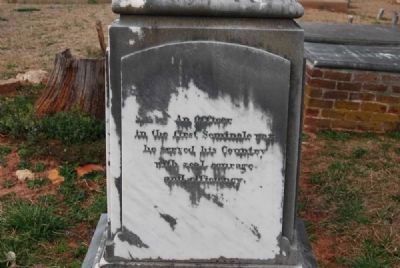
Photographed By Brian Scott, March 14, 2011
22. Maj. James Alston
Tombstone
Tombstone
in the First Seminole War
he served his country
with zeal, courage
and efficiency.
Click for more information.
Pvt. William Henry Perrin (1833-1863), son of Thomas Chiles Perrin (q.v.) and brother of Pvt. Thomas Samuel Perrin (q.v.), Confederate soldier; A.B., South Carolina College, 1858; enlisted in Company B, the “McDuffie Guards,” 1st South Carolina Rifles (Orr’s Rifles), 20 July 1861; killed in action at Gaines’s Mill, Virginia, 27 June 1862.[30]
Rev. Claudius Hornsby Pritchard (1821-1896), Methodist minister; born in Charleston, he was ordained by the South Carolina Conference, 1841, and served for forty-two years as a circuit rider, minister, and elder; among his appointments were as minister of Washington Street Methodist Church, Columbia, 1856-57, and as presiding elder there 1865-68; he was living in Abbeville at the time of his death.[31]
Alexander McDuffie Reid (1830-1855), college and divinity student; educated at a private academy in Greenwood, 1850-51; delivered an address favoring secession at Greenwood, July 1850; enrolled at South Carolina College, 1852, in the Class of 1855; member of the Clariosophic Society; left his class without graduating, intending to become
a minister, but died before he could do so.[32]
Lt. Frederick William Selleck (1824-1853), officer during the Mexican War, newspaper editor, and public servant; enlisted in the “McDuffie Guards,” Palmetto Regiment, December 1846; volunteer aide-de-camp to Gen. John A. Quitman; planted the flag of the Palmetto Regiment, the first American flag to fly there, on the fort at Garita de Belen, 13
Mexico City, 13 September 1847, and was severely wounded; editor of the Abbeville Banner; ordinary, Abbeville District, 1848-1852.[33]
Judge Thomas Thomson (1818-1881), lawyer, planter, state representative and senator, signer of the Ordinance of Secession, Confederate officer, and judge; South Carolina House of Representatives, 1846-1859; Abbeville District delegation, Secession Convention, 1860; captain, Company A, 1st South Carolina Rifles (Orr’s Rifles), 22 October 1861; promoted to major and transferred to 2nd South Carolina Rifles, 15 May 1862; lieutenant colonel, 6 July 1862; colonel, 3 September 1862; resigned 10 December 1863 to take seat in the South Carolina Senate; South Carolina Senate, 1863-1866; judge, Eighth Judicial Circuit, 1878-1881.[34]
Dr. Joseph Togno (d. 1859), French naval officer, physician and lecturer, professor of languages, and planter; he was born in Corsica and served in the French Navy during the
Napoleonic Wars; M.D., University of Pennsylvania, 1829; translated Beclard’s Elements of General Anatomy from its original French and published it in Philadelphia in 1830; on the faculty of the College of Physicians of Philadelphia, 1834, and also a member of the Philadelphia Medical Society; later a lecturer and author on various medical subjects; tutor of Italian and French, University of Virginia, 1840-41; moved to Wilmington, N.C., in the 1840s, where he became an expert in cultivating grapes and producing wine, and authored articles on wine culture in agricultural and horticultural journals; moved to Abbeville in 1854, where he built a rock house which he named “Montevino.”[35]
Judge David Lewis Wardlaw (1799-1873), lawyer, state representative, signer of the Ordinance of Secession; A.B., South Carolina College, 1816; South Carolina House of Representatives, 1826-29, 1831-41; Speaker, 1836-1841; circuit court judge, 1841-1865; Abbeville District delegation, Secession Convention, 1860; president, South Carolina Constitutional Convention, 1865.[36]
Capt. George Allen Wardlaw (1837-1865), lawyer and Confederate officer; A.B., South Carolina College, 1857; admitted to the bar, 1859; enlisted as 2nd lieutenant in Company E, 1st South Carolina Infantry (Butler’s), March 1861; serving as quartermaster of the regiment, fall 1861-winter 1864; temporarily commanding Company I, 1st South Carolina Infantry, when wounded at Sullivan’s Island, South Carolina, 8 September 1863; resigned as 1st lieutenant and assistant quartermaster, 2 March 1864; appointed 1st lieutenant and aide-de-camp to Brig. Gen. Samuel McGowan, 16 March 1864; captured near Richmond, Virginia, 28 July 1864; imprisoned at Fort Delaware, Delaware, and paroled for exchange 7 February 1865; died in Savannah, Georgia, 9 July 1865, from the effects of his stay as a prisoner of war; Wardlaw’s body was brought to Abbeville and reburied in Upper Long Cane Cemetery 8 March 1866.[37]
James Wardlaw (1767-1842), Abbeville District clerk of court 1800-1838.[38]
James Witherspoon Wardlaw (1840-1860), college student; enrolled at South Carolina College, 1858, in the Class of 1860; member of the Clariosophic Society; died in Columbia at the home of Dr. James Henley Thornwell, 6 July 1860.[39]
Sgt. Lewis Alfred Wardlaw (1844-1863), Confederate soldier; enlisted as a 4th sergeant in Company B, the “McDuffie Guards,” 1st South Carolina Rifles (Orr’s Rifles), 20 July 1861; promoted to 1st sergeant; wounded at Fredericksburg, Virginia, 13 December 1862; mortally wounded at Chancellorsville, Virginia, 3 May 1863; died at home at Abbeville, 6 June 1863.[40]
Pvt. Robert Henry Wardlaw, Jr. (1840-1865),
Confederate soldier; enlisted in Company B, the “McDuffie Guards,” 1st South Carolina Rifles (Orr’s Rifles), 20 July 1861; wounded at Fredericksburg, Virginia, 13 December 1862; wounded near Petersburg, Virginia, 31 March 1865; furloughed for sixty days from General Hospital at Danville, Virginia, 9 April 1865; died at home in Abbeville, 5 May 1865.[41]
Pvt. Samuel Watt (1741-1802), soldier during the American Revolution; served in the South Carolina militia and provided flour to the militia in 1782.[42]
Capt. William Henry White (1836-1862), Confederate officer; A.B., South Carolina College, 1857; enlisted as 1st lieutenant, Company A, 1st South Carolina Rifles (Orr’s Rifles), 22 October 1861; elected captain and transferred to Company K, 2nd South Carolina Rifles, 2 April 1862; killed at 2nd Manassas, Virginia, 30 August 1862.[43]
Pvt. James Samuel Willson (1841-1863), college student and Confederate soldier; member of the Class of 1862 at Erskine College, Due West, Abbeville District, S.C., February 1861, when he left to enlist in Company B, 7th South Carolina Infantry; promoted to corporal, 8 August 1861; diagnosed with rheumatism and discharged, April 1862; reenlisted in Company G, 1st South Carolina Rifles (Orr’s Rifles), 5 March 1863; killed in action at Chancellorsville, Virginia, 3 May 1863.[44]
Rev. J. Lowrie Wilson (1839-1909), Presbyterian minister; born in India as the son of missionaries, and educated at Davidson College and the Columbia Theological Seminary; Wilson served at Bethesda Presbyterian Church, in York County, 1869-1885, then at Abbeville Presbyterian Church, 1886-1909.[45]
Art
Upper Long Cane Cemetery includes more than fifty gravemarkers “signed” with the stonecutters’ names on them or attributable by style to particular carvers and their shops, most notably those carved by prominent Charleston, South Carolina, stonecutters Rowe and White (the partnership of James Rowe and John White, active ca. 1819-1825), John White (active ca. 1822-ca. 1850),[46] William T. White (active ca. 1850-ca. 1870), Robert D. White (active ca. 1855-ca. 1875), and Edwin R. White (active ca. 1860-ca. 1882).[47]
John and William T. White, father and son, were members of the second and third generation of stonecutters related to master stonecarver Thomas Walker (active ca. 1790-ca. 1836), a native of Scotland who arrived in Charleston shortly after the American Revolution.[48]
Thomas Walker and his sons David A. Walker, James E. Walker, Robert D. Walker, and William S. Walker (Walker’s sons were active ca. 1835-ca. 1860)[49] were joined or followed in the craft by his son-in-law John White and his grandsons William T. White, Robert
D. White (active ca. 1855-ca. 1875), and Edwin R. White (active ca. 1860-ca. 1882).[50] Three generations of Walkers and Whites, all of whom were based in Charleston, were skilled artisans whose combined work spanned the late eighteenth century to the late nineteenth century.
The Walkers’ and Whites’ stones—usually cut from high-quality Italian marble, and carved with a grace and sophistication surpassing most other gravestone art in South Carolina and the rest of the region for this period—have been noted by several historians, art historians, and other scholars of historic funerary art in the Southeast. Relatively little in-depth research, however, has been conducted on the Walkers and the Whites; most of what is known is based on census records, listings in city directories, newspaper advertisements, and similar sources, and assessments of their standing are based on scholars’ familiarity with surviving examples of their work as viewed in context with the typical gravestone art of their day.
Hundreds of their gravestones stand in cemeteries large and small across South Carolina. Two particularly significant cemeteries representative of the “rural cemetery movement” of the nineteenth century that include concentrations of stones carved by William T. White, Robert D. White, and Edwin R. White are Magnolia Cemetery in Charleston, established in 1849-50 and listed in the National Register on March 24, 1978, and Elmwood Cemetery in Columbia, established in 1854 and listed in the National Register on September 6, 1996.
Many other examples of the Whites’ work are present in public, church, and family cemeteries from the lowcountry to the upcountry. The Edgar Fripp Mausoleum (W.T. White, 1852), at the St. Helena Parish Church, St. Helena Island, a particularly impressive Egyptian Revival mausoleum at an isolated rural Episcopal parish churchyard in Beaufort County, was individually listed in the National Register as part of the “Historic Resources of St. Helena Island, ca. 1740-ca. 1935” under Criterion C, with Art as an Area of Significance, on October 6, 1988. Three other South Carolina cemeteries are already listed in the Register containing notable examples of the work of the Walkers and Whites and listed in part under Criterion C, with Art as an Area of Significance: the Coming Street Cemetery, in Charleston, Charleston County, listed November 5, 1996; the Lucas Family Cemetery, in Mount Pleasant, Charleston County, listed May 18, 1998; and Cook’s Old Field Cemetery (Hamlin Cemetery), Mount Pleasant vicinity, Charleston County, listed May 9, 2003.
Since the Whites were based in Charleston, with their “Marble Yards” on Meeting Street from the 1820s into the 1880s, most of their
stones in the city and the lowcountry are simply signed with their names. Elsewhere in the state, however, they often signed their stones with the designation “Charleston,” “Charleston, S.C.,” “Ch. So. Ca.,” or “Ch. S.C.”
The concentration of White-carved stones in Upper Long Cane Cemetery is important in the context of other cemeteries in the state. Magnolia Cemetery and such Charleston cemeteries as St. Michael’s Episcopal Church, St. Philip’s Episcopal Church, Circular Congregational Church, and First Scots Presbyterian Church, for example, contain numerous stones carved by the Walkers and Whites, but most other South Carolina cemeteries, especially those in more rural areas outside the city centers of Charleston and Columbia, do not contain nearly as many examples, or as fine examples, as those at Upper Long Cane Cemetery.
This concentration is also particularly notable for its presence in Abbeville, as a district or county seat which was not the commercial, political, and population center that Charleston—or, to a slightly lesser extent, the state capital at Columbia—was in the early-to-mid nineteenth century. Abbeville was, nevertheless, a locus of commerce, politics, and social power in the western South Carolina upcountry of the time.
Stones at Upper Long Cane Cemetery carved by the Walkers
and Whites are, furthermore, a tangible illustration of the social, economic, and political status of the families who commissioned them to carve high-quality and high-priced gravestones for their dearly-departed dead, particularly so in the case of numerous Confederate officers and men buried here who died of disease, were killed in action, or were mortally wounded and died soon afterwards, during the Civil War.
For much of the first half of the nineteenth century, the most affluent and prominent families preferred ledger tombs, either placed directly on the ground or on a box-tomb or table-top-tomb. Gradually, however, tastes began to favor Classical Revival or Gothic Revival tablets, which one scholar of gravestone art has aptly called “silhouettes,”[51] with shallow round, pointed, or segmental arches, sometimes featuring beaded borders as their only real decoration, but in other instances featuring more detailed and elaborate three-dimensional relief elements, as outward manifestations of their status. By the mid-point of the nineteenth century well-to-do families typically erected such stones for children and adults like, and erected monuments such as obelisks and pedestal tombs for the most prominent adults among them.
The three most popular styles of funerary art in the mid-nineteenth century were the Classical Revival (usually combining elements
of Greek and Roman forms), the Gothic Revival, and the Egyptian Revival, and the Whites were not only conversant with but accomplished in rendering elements of all three, as the tastes, wishes, and means of their clients might dictate.
Particularly significant examples of their work in the Classical Revival style at Upper Long Cane Cemetery include (in chronological order) the gravestones of Eliza Thomson, Alexander McDuffie Reid, Samuel Reid, Pvt. James Samuel Willson, and Capt. William Henry White. Particularly significant examples of their work in the Gothic Revival style here include (in chronological order) the gravestones of James Witherspoon Wardlaw, Pvt. William Henry Perrin, Pvt. Thomas Samuel Perrin, and Capt. George Allen Wardlaw.
Numerous gravestones at Upper Long Cane Cemetery were commissioned by grieving parents for sons who died in early adulthood—from twenty to thirty years old—while a few of them were college students or recent graduates, the rest were Confederate soldiers who died of disease, were killed in action, or were mortally wounded and died soon afterwards.
Particularly significant examples of these memorials include (in chronological order) the gravestones of William Langdon Bowie, Alexander McDuffie Reid, James Witherspoon Wardlaw, Pvt. William Henry Perrin, Pvt. Robert Henry Wardlaw, Jr., Pvt. Thomas Samuel Perrin,
Pvt. James Samuel Willson, Sgt. Lewis Alfred Wardlaw, Capt. George Allen Wardlaw, Sgt. William Tully Norwood, and Pvt. Robert Henry Wardlaw. The gravestones of Sgt. William Tully Norwood and Capt. George Allen Wardlaw are of particular interest in the context of the Reconstruction era, as their remains were relocated from their original graves in Petersburg, Virginia, and Savannah, Georgia, respectively, and brought back to Abbeville for reburial at Upper Long Cane Cemetery in March 1866.
Notes
1. For a listing of graves in the cemetery as of 1983, see “Upper Long Cane Presybterian Church,” in R. Wayne Bratcher, compiler, Cemetery Records of Abbeville County, South Carolina, Volume Two (Greenville, S.C.: A Press, 1983), pp. 1-65.
2. The form of this sarcophagus, and the slightly more detailed sarcophagus depicted on the tablet of Alexander McDuffie Reid (q.v.), is strikingly similar to Plate IX, “Mural Tablets etc. in Westminster Abbey,” in J. Jay Smith [John Jay Smith], Designs for Monuments and Mural Tablets; Adapted to Rural Cemeteries, Church Yards, Churches and Chapels. With a Preliminary Essay on the Laying Out, Planting and Managing of Cemeteries and on the Improvement of Church Yards. On the Basis of London’s Work. By J. Jay Smith, One of the Founders of Laurel Hill Cemetery, Philadelphia (New York: Bartlett & Welford),
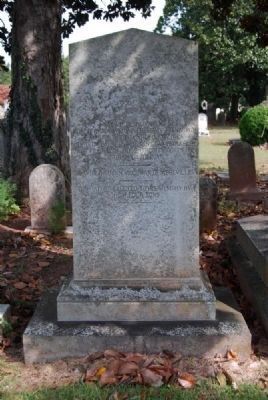
Photographed By Brian Scott, November 2, 2010
34. Judge William Christie Benet Tombstone Reverse
Graduate University of Edinburgh
Came to South Carolina in 1868
Gifted Teacher, Brilliant Lawyer, Able
and Fearless Judge Circuit Courts of
South Carolina
----------
Married Susan McGowan of Abbeville
----------
Stone erected to His Memory by
Their Four Sons
3. Some Cemetery Records of Abbeville County, South Carolina (Baltimore: Genealogical Publishing Company, 1982; reprint ed., 1993), p. 49.
4. See Smith, Plate IX.
5. Mary Hemphill Greene, “’Long Cane’ A Prominent Name In Abbeville County: First In A Series of Articles To Be Written on Long Cane Cemetery and the Heroes Who Are Buried There,” 28 February 1935; Greene,“Long Cane Cemetery History Is Compiled For First Time,” 24 June 1935, The Press and Banner and Abbeville Medium (Abbeville, S.C.).
6. Greene, “Long Cane Society,” The Press and Banner and Abbeville Medium (Abbeville, S.C.), 11 April 1935; Pearl M. Stevenson, “Keeping the Faith”: A History of Upper Long Cane Presbyterian Church, Abbeville, South Carolina, 1763-1976 (Greenwood: Drinkard Printing Company, 1976), p. 12.
7. Greene, “Long Cane Cemetery Is Compiled For First Time;” “To Deliver Address at Long Cane Thursday. Program Complete For Dedication Services at Cemetery Thursday Noon. Long Cane Cemetery Society Takes Interest in Historic Burial Ground. Dedicate Wall to
Vets. Tablets Unveiled. Memorial Tablets To Be Unveiled Thursday, June 27 At Entrance To Cemetery.” The Press and Banner and Abbeville Medium (Abbeville, S.C.), 24 June 1935; “Large Crowd Attends Exercises At Long Cane Cemetery This Morning,” The Press and Banner and Abbeville Medium (Abbeville, S.C.), 27 June 1935.
8. “South Carolina First. The First Martyr of the Lost Cause Was Young James Clark Allen, at Sullivan’s Island,” Charlotte Observer (Charlotte, N.C.), 29 June 1897; Greene, “Long Cane Cemetery History Is Compiled For First Time;” Lowry Ware, Old Abbeville: Scenes of the Past of a Town Where Old Time Things Are Not Forgotten (Columbia: SCMAR, 1992), p. 80; W.A. Swanberg, First Blood:The Story of Fort Sumter (New York: Charles Scribner’s Sons, 1957), p. 216; David Detzer, Allegiance: Fort Sumter, Charleston, and the Beginning of the Civil War (New York, San Diego, & London: Harcourt, 2001), p. 196.
National Archives Microcopy M267, Roll 135, Compiled Service Records of Confederate Soldiers Who Served in Organizations From the State of South Carolina, First (Orr’s) Rifles, A-Bo; Compiled Service Records hereafter cited as National Archives Microcopy number, Compiled Service Records, roll number, and unit designation.
9. Joseph A. Groves, The Alstons and Allstons of North and South Carolina, Compiled from English,
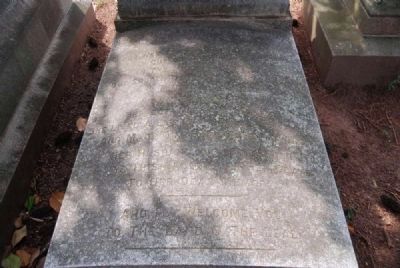
Photographed By Brian Scott, February 28, 2011
36. Susan McGowan Benet Tombstone
Tablet Inscription
Tablet Inscription
Died 21 July 1898
She was taken from us too soon
Cut off at unawares
on the midst of her day
But sudden death found her ready
Trusting in God.
Her husband and four sons
raise this cross over her grave
to her dear memory.
----------
And I'll welcome you
to the Land of the Leal
10. William B. Sprague, Annals of the American Pulpit; or Commemorative Notices of Distinguished American Clergymen of Various Denominations, from the Early Settlement of the Country to the Close of the Year Eighteen Hundred and Fifty-Five (New York: Robert Carter & Brothers, 1860), Volume IV, pp. 384-87; George Howe, History of the Presbyterian Church in South Carolina, Volume II (Columbia: W.J. Duffie, 1883), pp. 147, 544-45, 732-33; F.D. Jones and W.H. Mills, History of the Presbyterian Church in South Carolina Since 1850 (Columbia: The R.L. Bryan Company for the Synod of South Carolina, 1926), pp. 1061; Greene, “Long Cane Cemetery History Is Compiled For First Time.”
11. U.R. Brooks, South Carolina Bench and Bar, Volume I (Columbia: The State Company, 1908), pp. 286-87.
12. Obituary, South Carolina State Gazette (Columbia, S.C.), 13 October 1827; Lists of County Officials of Abbeville District in Lists of County Officials of South Carolina, ca. 1790-ca. 1966, South Carolina Department of Archives and History, Columbia, S.C., hereafter cited as Lists of County Officials, SCDAH; Francis B. Heitman, Historical Register of the Officers of the Continental Army During
the War of the Revolution, April, 1775 to December, 1783 , New, Revised and Enlarged Edition (Washington: The Rare Book Shop Publishing Co., 1914), p. 112; Bobby Gilmer Moss, Roster of South Carolina Patriots in the American Revolution (Baltimore: Genealogical Publishing Co., 1983), p. 83; Ware, pp. 1, 6, 235.
13. National Archives Microcopy M267, Compiled Service Records, Roll 137, First (Orr’s) Rifles, Co-Fo; Cyclopedia of Eminent and Representative Men of the Carolinas of the Nineteenth Century…, Volume I (Madison, Wis.: Brant & Fuller, 1892), pp. 200-01; Brooks, pp. 265-66; Clement A. Evans, ed., Confederate Military History. Volume VI: South Carolina, Extended Edition (Atlanta: Confederate Publishing Company, 1899; reprint ed., Wilmington, N.C.: Broadfoot Publishing Company, 1987), pp. 515-17; Yates Snowden, ed., History of South Carolina, Volume IV (Chicago and New York: The Lewis Publishing Company, 1920), pp. 271-72; Biographical Directory of the United States Congress, 1774-1989, Bicentennial Edition (Washington: U.S. Government Printing Office, 1989), p. 831.
14. David Duncan Wallace, The History of South Carolina, Biographical Volume (New York: The American Historical Society, 1935), pp. 680-81; Ware, p. 232.
15. Moss. p. 298.
16. Ibid.
17. Cyclopedia of Eminent and Representative Men, pp. 201-04; Brooks, pp. 78-80; Snowden,
pp. 3-6; N. Louise Bailey, Mary L. Morgan, and Carolyn R. Taylor, eds., Biographical Directory of the South Carolina Senate 1776-1985, Volume I, Abbott-Hill (Columbia: University of South Carolina Press, 1986), pp. 551-52.
18. Biographical Directory of the United States Congress, p. 1047; Veronica Bruce McConnell, “Frank Boyd Gary,” in Walter B. Edgar, ed., The South Carolina Encyclopedia (Columbia: University of South Carolina Press, 2006), pp. 360-61.
19. Obituary, Daily National Intelligencer (Washington, D.C.), 4 February 1835; Lists of County Officials, SCDAH; Groves, pp. 231-33; Moss, p. 404; N. Louise Bailey & Elizabeth Ivey Cooper, eds., Biographical Directory of the South Carolina House of Representatives, Volume III: 1775-1790 (Columbia: University of South Carolina Press, 1981), pp. 298-99; Ware, pp. 1-2, 18-20, 25.
20. Bailey, Morgan, and Taylor, eds., Biographical Directory of the South Carolina Senate 1776-1985, Volume II: Hines-Singleton (Columbia: University of South Carolina Press, 1986), pp. 740-41.
21. “Death of Dr. J.F. Livingston,” 1 November 1867, and “In Memoriam of John F. Livingston,” 31 January 1868, Abbeville Press (Abbeville, S.C.); Lists of County Officials, SCDAH; Ware, pp. 30, 231.
22. National Archives Microcopy M331, Compiled Service Records, Roll 171, Confederate General
and Staff Officers and Non-Regimental Enlisted Men; J.F.J. Caldwell, History of a Brigade of South Carolinians first known as “Gregg’s” and Subsequently as “McGowan’s Brigade.” (Philadelphia: King and Baird, Printers, 1866; reprint edition, with introduction, notes, and index by Lee A. Wallace, Jr., Dayton, Ohio: Morningside Press, 1984), pp. 101-04; Cyclopedia of Eminent and Representative Men, pp. 208-212; Brooks, pp. 72-77; Jeffry D. Wert, “Samuel McGowan,” in William C. Davis, ed., The Confederate General, Volume 4 (Harrisburg, Pa.: The National Historical Society), pp. 122-23; John H. Eicher and David J. Eicher, Civil War High Commands (Stanford; Stanford University Press, 2001), p. 379.
23. National Archives Microcopy M841, Roll 114, Record of Appointment of Postmasters 1832-September 30, 1971, South Carolina: Abbeville-Greenwood Counties; Ware, pp. 33, 235.
24. Wesley C. Norwood, The Therapeutical Powers and Properties of Veratrum Viride (New York, 1854); “Obituary. Dr. Wesley C. Norwood,” New York Herald-Tribune, 17 July 1884; Obituary, Gaillard’s Medical Journal and the American Medical Weekly XXXVIII:1 (July 1884), 240; Joseph Ioor Waring, A History of Medicine in South Caroilna 1825-1900 (Columbia: South Carolina Medical Association, 1967), pp. 227-78; J. Sumter Rhame, “Dr. W.C. Norwood and Norwood’s
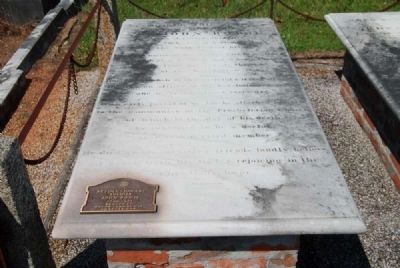
Photographed By Brian Scott, November 19, 2010
40. Maj. John Bowie Tombstone
are deposited the mortal remains of
Major John Bowie
who departed this life
on the 20th day of September 1827
in the 88th year of his age.
He was a native of Dumbartonshire in Scotland
from which place he emigrated to South Carolina
many years previous to the war
of the Revolution.
During the whole of that eventful & trying affair
he was an officer of the Revolutionary Army
and in service almost everyday.
At an early period of his life he attached himself
in the communion of the Presbyterian Church
of which to the day of his death
he continued to be a useful,
zealous & devoted member.
He died as his surviving friends fondly believe
at peace with his God; & rejoicing in the
Christian's hope.
25. Andrew Charles Moore, Roll of Students of South Carolina College 1805-1905 (Columbia: University of South Carolina, 1905), p. 29; “Obituary of Sgt. W. Tulley Norwood,” Abbeville Press (Abbeville, S.C.), 23 March 1866; National Archives Microcopy M267, Compiled Service Records, Roll 377, Holcombe Legion, Mc-Pa.
26. “Death of Capt. M.T. Owen,” Abbeville Press (Abbeville, S.C.), 7 August 1863; Ware, pp. 67, 181, 221; National Archives Microcopy M267, Compiled Service Records, Roll 6, First Cavalry, O-Se.
27. Jack Allen Meyer, South Carolina in the Mexican War: A History of the Palmetto Regiment of Volunteers 1846-1917 (Columbia: South Carolina Department of Archives and History, 1996), pp. 137-38; National Archives Microcopy M267, Compiled Service Records, Roll 142, First (Orr’s) Rifles, N-Ri; “Battle of Chancellorsville,” Abbeville Press (Abbeville, S.C.), 15 May 1863; Perrin, “Abbeville’s Five Colonels,” The Press and Banner and Abbeville Medium (Abbeville, S.C.), 30 June 1932; Caldwell, pp. 121-22; Ware, p. 94.
28. National Archives Microcopy M267, Compiled Service Records, Roll 142, First (Orr’s) Rifles, N-Ri.
29. Moore, Roll of Students, p. 11; John Amasa May and Joan Reynolds Faunt,
South Carolina Secedes (Columbia: University of South Carolina Press, 1960), pp. 192-93; Chalmers Gaston Davidson, The Last Foray: The South Carolina Planters of 1860: A Sociological Study (Columbia: University of South Carolina Press, 1971), p. 237; N. Louise Bailey, Mary L. Morgan, and Carolyn R. Taylor, Biographical Directory of the South Carolina Senate 1775-1985,Volume II: Hines-Singleton (Columbia: University of South Carolina Press, 1986), pp. 1253-55; Ware, pp. 58-59, 75, 231.
30. Moore, Roll of Students, p. 27; National Archives Microcopy M267, Compiled Service Records, Roll 142, First (Orr’s) Rifles, N-Ri.
31. Abel McKee Chreitzberg, Early Methodism in the Carolinas (Nashville: Publishing House of the Methodist Episcopal Church, South, 1897), pp. 263, 363-64.
32. Andrew Charles Moore, compiler, Alumni Records, South Carolina College, 1805-1905, Volume 6, P-Sh, University Archives, South Caroliniana Library, University of South Carolina, Columbia, S.C.; Moore, Roll of Students, p. 26, where his middle name is incorrectly given as “Maxadeau (or Maxadean);” A.M. Reid, “North and South” (Greenwood, S.C., July 1850), in Norris and Thomson Famlies Papers, South Caroliniana Library, University of South Carolina, Columbia, S.C.; Samuel Reid to Susan Miller, 15 February 1851, 9 June 1851, 2 May 1852, and 15 July 1853, in the Reid Family Letters, 1802-1855, Miller and Reid Families Papers, Private Collection of Charles Miller, with transcriptions and annotations available online at http://homepage.mac.com/bpthompson/miller_reid_families/index.htm (accessed 28 September 2010).
33 “The Palmetto Regiment” and “Another Letter From Palmetto Regiment,” 24 November 1847, and “Correspondence To The Banner,” 5 January 1848, Abbeville Banner (Abbeville, S.C.); Lists of County Officials, SCDAH; Meyer, pp. 97, 99; Mary Hemphill Greene, “Fred W. Selleck, Abbevillian, Is Hero In The Mexican War,” The Press and Banner and Abbeville Medium (Abbeville, S.C.), 2 January 1933; “Accident at a Camp-Meeting,” Daily National Intelligencer (Washington, D.C.), 5 October 1852, in Joan M. Dixon, compiler, National Intelligencer Newspaper Abstracts (Westminster, Md.: Heritage Books, 2008), p. 433.
34. Obituary, New York Herald-Tribune, 7 May 1881; National Archives Microcopy M267, Compiled Service Records, Roll 168, Second Rifles, Th-Y; May and Faunt, p. 217-19; Brooks, pp. 258-59; N. Louise Bailey, Mary L. Morgan, and Carolyn R. Taylor, eds., Biographical Directory of the South Carolina Senate 1776-1985, Volume III: Sinkler-Index (Columbia: University of South Carolina Press, 1986), pp. 1601-03.
35. Obituary, Abbeville Press (Abbeville, S.C.), 11 February 1859, reprinted in Ware, pp. 68-70; Obituary, Charleston Mercury (Charleston, S.C.), 9 February 1859; Lester W. Ferguson, Abbeville County: Southern Life-Styles Lost in Time (Spartanburg: The Reprint Company, 1993), pp. 31-35.
36. Moore, Roll of Students, p. 7;Cyclopedia of Eminent and Representative Men, pp. 207-08; May and Faunt, p. 222-23.
37. “Death of George Allen Wardlaw,” Abbeville Press (Abbeville, S.C.), 2 March 1866; Moore, Roll of Students, p. 27; National Archives Microcopy M267, Roll 118, Compiled Service Records, 1st (Butler’s) Infantry, Th-Y; National Archives Microcopy M331, Roll 259, Compiled Service Records, Wam-Warn; gravestone in Upper Long Cane Cemetery.
38. Lists of County Officials, SCDAH.
39 Moore, compiler, Alumni Records, South Carolina College, 1805-1905, Volume 7, Si-Z, University Archives; Moore, Roll of Students, p. 29; gravestone, Upper Long Cane Cemetery.
40. “At Home,” 5 June 1863, and “Death of Lewis Alfred Wardlaw,” 19 June 1863, Abbeville Press (Abbeville, S.C.); National Archives Microcopy M267, Compiled Service Records, Roll 144, First (Orr’s Rifles), T-Z; gravestone, Upper Long Cane Cemetery.
41. National Archives Microcopy M267, Compiled Service Records, Roll 144, First (Orr’s) Rifles, T-Z; gravestone, Upper Long Cane Cemetery.
42. Moss, p. 972.
43. Moore, Roll of Students, p. 27; National Archives Microcopy M267, Compiled Service Records, Roll 168, Second Rifles, Th-Y.
44. National Archives Microcopy M267, Compiled Service Records, Roll 222, 7th Infantry, To-Z; M267, Roll 144, First (Orr’s) Rifles, T-Z; gravestone, Upper Long Cane Cemetery.
45. Jones and Mills, pp. 140-41, 218, 228, 505, 981; Edgar Sutton Robinson, The Ministerial Directory of the Ministers in “The Presbyterian Church in the United States” (Southern), and in “The Presbyterian Church in the United States of America” (Northern), Together with a Statement of the Work of the Executive Committees and Boards of the Two Churches, with the Names and Location of Their Educational Institutions and Church Papers, Volume I (Oxford, Oh: The Ministerial Directory Company, 1898), p. 103; gravestone, Upper Long Cane Cemetery.
46. For the partnership of James Rowe and John White, see Gene Waddell, Charleston Architecture 1670-1860, Volume I (Charleston: Wyrick & Company, 2003), pp.165, 169-71, 179-181; and the listings in James W. Hagy, compiler, Charleston, South Carolina City Directories For the Years 1816, 1819, 1822, 1825, and 1829 (Baltimore: Clearfield Company, 1996), pp. 60, 97, 129. For John White, see Beatrice St. Julien Ravenel, Architects of Charleston (Charleston: Carolina Art Association, 1945), pp. 171-72, 184; Anna Wells Rutledge, Artists in the Life of Charleston: Through Colony and State from Restoration to Reconstruction , Transactions of the American Philosophical Society, New Series, Volume 39, Part 2 (Philadelphia: American Philosophical Society, 1949; reprint edition, with a new preface by John Morrill Bryan, Columbia: University of South Carolina Press, 1980), p. 225; Michael Trinkley, An Archaeological Reconnaissance of Hobcaw Plantation, Charleston County, S.C., Chicora Foundation Research Series 10 (Columbia: Chicora Foundation, 1987), pp. 37-38; Alice Gaillard Palmer to Harriet R. Palmer, 16 May 1866, in Louis P. Towles, ed., A World Turned Upside Down: The Palmers of South Santee, 1818-1881 (Columbia: University of South Carolina Press, 1996), p. 513; White’s advertisement in the City Gazette and Daily Advertiser (Charleston, S.C.), 1 November 1830; and “Tribute To The Memory of Col. Charles John Steedman,” Southern Patriot (Charleston, S.C.), 17 March 1840. For White’s active years, see the listings in Hagy, compiler, Charleston, South Carolina City Directories For the Years 1816, 1819, 1822, 1825, and 1829, pp. 103, 134, 162; James W. Hagy, compiler, Directories for the City of Charleston, South Carolina For the Years 1830-31, 1835-36, 1837-38, and 1840-41 (Baltimore: Clearfield Company, 1997), pp. 29, 64, 93, 131, and James W. Hagy,
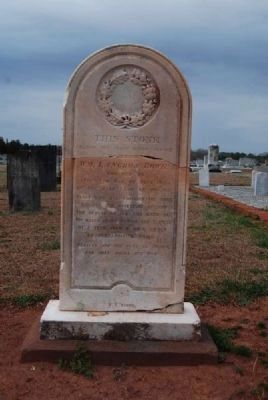
Photographed By Brian Scott, March 4, 2011
46. William Langdon Bowie Tombstone
Carved by W.T. White
Carved by W.T. White
marks the place where repose
the Remains of
Wm. Langdon Bowie
who died on
the 7th Day of Sept. 1851
in the 24th year of his age.
Blest with a disposition the most
amiable and unselfish, he won
the hearts of all who knew him.
His early grave claims the tribute
of a tear, from a wide circle
of sympathizing friends.
----------
"Blessed are the pure in heart
for they shall see God."
47. For William T. White, see Trinkley, pp. 38-39; Theodore Rosengarten, Tombee: Portrait of a Cotton Planter, with the Journal of Thomas B. Chaplin (1822-1890), edited and annotated with the assistance of Susan W. Walker (New York: William Morrow & Company, 1986), Thomas B. Chaplin, Journal, Entry of 13 April 1852, pp. 567-68; Waddell, pp. 239, 242; “Monument to Col. Washington,” 13 March 1858, “The William Washington Monument,” 26 April 1858, “The Dedication at Magnolia,” 6 May 1858, “Monument to the Memory of Preston S. Brooks,” 14 July 1858, “The Hudson Monument,” 23 September 1858, “Improvement,” 6 January 1859, and “Improvements,” 27 August 1859, Charleston Mercury (Charleston, S.C.); and White’s advertisement for “STEAM MARBLE WORKS. WM. T. WHITE,” in the Charleston Mercury (Charleston, S.C.), 3 September 1859. For W.T. White’s active years, see the listings in Hagy, compiler, Directories For the City of Charleston, South Carolina For the Years 1849, 1852, and 1855, p. 174, and James W. Hagy, compiler, On The Eve of the Civil War: The Charleston, S.C. Directories For the Years 1859 and 1860, with Additional Information from
the City Census of 1861 (Baltimore, Clearfield Company, 2000), pp. 79, 166; and Jowitt’s Illustrated Charleston City Directory and Business Register, 1869-70, Containing a Complete Street Directory… (Charleston: Walker, Evans, & Cogswell, Printers, 1869), p. 218.
48. For Thomas Walker, see Ravenel, pp. 87-88; Rutledge, p. 223; and especially Diana Williams Combs, Early Gravestone Art in Georgia and South Carolina (Athens and London: University of Georgia Press, 1986), pp. 2-3, 22-23, 71-78, 106-23, 127-30, 197-98, 202-03. See also Walker’s advertisements in the City Gazette and Daily Advertiser (Charleston, S.C.), 15 February 1798, 8 December 1806, 26 June 1809, and a brief article in the City Gazette and Commercial Daily Advertiser (Charleston, S.C.), 16 October 1826. For Walker’s active years, see the listings in Hagy, compiler, Charleston, South Carolina City Directories For the Years 1816, 1819, 1822, 1825, and 1829, pp. 28, 102, 133, 161, and Hagy, compiler, Directories For the City of Charleston, South Carolina For the Years 1830-31, 1835-36, 1836, 1837-38, and 1840-41, pp. 28-64.
49. For Walker’s sons, see Trinkley, p. 37; for their active years, see the listings in Hagy, compiler, Directories for the City of Charleston, South Carolina For the Years 1830-31, 1835-36, 1836, 1837-38, and 1840-41, pp. 64, 92, 130; and Hagy, compiler, Directories For the City of Charleston, South Carolina For the Years 1849, 1852, and 1855, pp. 44, 105-06.
50. For Robert D. White and Edwin R. White, see Trinkley, pp. 38-40; “Improvements,” 27 August 1859, Charleston Mercury (Charleston, S.C.); and the listings in Hagy, compiler, Directories for the City of Charleston, South Carolina For the Years 1849, 1852, and 1855, p. 174; Hagy, compiler, On The Eve of the Civil War: The Charleston, S.C. Directories For the Years 1859 and 1860, pp. 79, 165-66, and especially Robert D. White’s illustrated advertisement for “WHITE’S MARBLE & STONE YARD” depicted on p. 83; Jowitt’s Illustrated Charleston City Directory and Business Register, 1869-70, p. 218 and advertisement in back section for “WHITE’S MARBLE WORKS. OLD ESTABLISHMENT”; A.E. Sholes and C.F. Weatherbe, Sholes & Co., Publishers, Sholes’ Directory of the City of Charleston, 1882 (N.p: n.p., 1882), pp. 596-97, and Edwin R. White’s advertisement on the back cover; and Southern Directory Publishing Co., Charleston City Directory Together With A Compendium of Governments, Institutions, and Trades of the City (Charleston: Lucas, Richardson, & Co., 1888), p. 562.
51. M. Ruth Little, Sticks and Stones: Three Centuries of North Carolina Gravemarkers, With Photography by Tim Buchman; The Richard Hampton Jenrette
Series in Architecture and the Decorative Arts (Chapel Hill and London: University of North Carolina Press, 1998).
— Submitted December 19, 2011, by Brian Scott of Anderson, South Carolina.
2. James Sproull Cothran (1830 - 1897)
James Sproull Cothran, a Representative from South Carolina; born near Abbeville, Abbeville County, S.C., August 8, 1830; attended the country schools; graduated from the University of Georgia, Athens, Ga, 1852; lawyer, private practice; Army, Confederate States of America; solicitor of the eighth judicial circuit of South Carolina,1876 and 1880; judge, eighth judicial circuit of South Carolina, 1881-1886; elected as a Democrat to the Fiftieth and to the succeeding Congress (March 4, 1887-March 3, 1891); was not a candidate for renomination to the Fifty-second Congress in 1890; died on December 5, 1897, in New York, N.Y.; interment in Upper Long Cane Cemetery, Abbeville, S.C. (Source: Biographical Directory of the U.S. Congress.)
— Submitted December 20, 2011, by Brian Scott of Anderson, South Carolina.
3. Judge James S. Cothran by T.P. Cothran
James S. Cothran, jurist, statesman, and soldier, was born in Abbeville County, South Carolina, August 8,
1830, son of Wade S and Elizabeth Sproull Cothran. His father, a native of Newberry County who made his home at Rome Georgia in 1850, was prominent as a banker and railroad president and died there in 1877, was a son of Samuel Cothran also a native of South Carolina. His mother Elizabeth was the daughter of James Sproull and his wife Rebecca Caldwell, the latter of whom was a cousin of John C Calhoun, whose grandfather and hers was William Caldwell, one of three brothers who emigrated from the north of Ireland, first settled in Pennsylvania, and later in the Piedmont region of South Carolina. Elizabeth Cothran's father was a soldier of the Revolution; also her uncle, Captain John Caldwell who with his wife was murdered by the notorious outlaw Bill Cunningham.
Judge Cothran was graduated at the Georgia University in 1852 and then, returning to Abbeville, he read law with Thomas C Perrin, a distinguished lawyer, State Senator, and president of the Greenville and Columbia Railroad. He was admitted to the bar in 1853, and in 1855, he was married to Emma C. the daughter of Mr. Perrin. In July 1861, he entered the Confederate service as orderly sergeant of Company B, Captain James M. Perrin of Orr's Regiment of Rifles. Captain Perrin was subsequently promoted colonel of the regiment and commanded it till he was killed at Chancellorsville and Sergeant Cothran became captain
of the company. He served with his regiment in the Army of Northern Virginia and took a gallant part in the excellent record of the regiment in many campaigns and battles. He was wounded in the battle of Second Manassas on August 29 1862, having his right leg broken by a ball; was shot through the right wrist at Chancellorsville; and at Jericho Ford, in May 1864, received a wound in the face. Finally he was surrendered at Appomattox, after which he resumed his law practice at Abbeville as the partner of his former preceptor Honorable T.C. Perrin.
He effectually supported the candidacy of General Hampton in 1876 as county Democratic chairman, and was elected Solicitor of the Eighth Judicial Circuit; in 1880 was reelected but he resigned the office in the following May to accept appointment by Governor Hagood to fill a vacancy in the judgeship of the circuit. He was reelected judge by the Legislature in 1881 and again in 1885 and retired from the office in December 1886 on account of his election to Congress. He served two terms in the national Legislature with distinction, part of the time as a member of the committee on foreign affairs. In January 1890, he became division counsel for the Richmond and Danville Railroad, a position which he held until his death on December 5 1897, then being a resident of Greenville. (Source: South Carolina Bench and Bar, Volume 1
by Ulysses Robert Brooks (1908) pgs 265-266.)
— Submitted December 20, 2011, by Brian Scott of Anderson, South Carolina.
4. James Sproull Cothran Biography
Judge James Sproull Cothran, August 8, 1830, Abbeville, S.C. - December 5, 1897, New York City, son of Frances Sproull and Wade S. Cothran. He was a graduate of the University of Georgia 1852 and returned to South Carolina to read Law under Thomas C. Perrin. James was admitted to the Bar 1853. He was first a lawyer before becoming a circuit judge in 1876 & 1880.
James married on July 17, 1855 65 to Emma Chiles Perrin (November 5, 1834 - September 21, 1916), daughter of Hon. Thomas Chiles Perrin. In the 1860 Federal Census James S. Cothran had a real estate value of $6500, and a personal estate valued at $22,000.
James CSA earned his way from Private to Captain in the Confederate Army, Orr's SC Regiment of rifles, enlisting in 1861 and serving until the surrender of Lee. He was first wounded in the Second Battle of Monasses (August 29, 1862), with his right leg broken by a ball, then at Chancellorsville (May 2, 1863) he was shot through the right wrist. Again, May 1864 near Spottsylvania he was shot through the face. As Captain of Co. B he surrendered at Appomattox.
James was Chairman of the Democratic
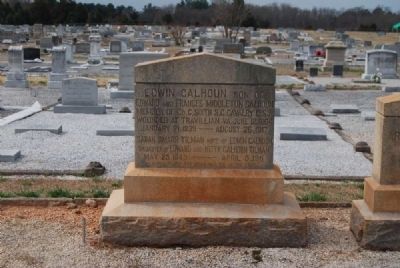
Photographed By Brian Scott, March 4, 2011
53. Edwin Calhoun & Sarah Smarr Tillman Tombstone
Edward and Frances Middleton Calhoun
Member of Co. C, Sixth S.C. Cavalry, C.S.A.
Wounded at Travillian, Va. June 12, 1864
January 21, 1839 --- August 26, 1917
Sarah Smarr Tilman, wife of Edwin Calhoun
Daughter of Edward and Kitty Calhoun Tilman
James Cothran died at a Sanitarium in New York City. He is buried in Upper Long Cane Cemetery in Abbeville, S.C.
— Submitted December 20, 2011, by Brian Scott of Anderson, South Carolina.
5. Thomas Perrin Cothran
Of the four sons of the late Captain Cothran, Thomas Perrin Cothran is the oldest of the family. He was educated at the University of Virginia and subsequently attended the law school of this institution. He has gained a place of high distinction among the lawyers of his native state, and now holds a responsible position in the legal department of the Southern Railway at Greenville. Several times, he has represented that county in the Legislature and was speaker of the House in the sessions of 1918 and 1919. (Source: History of South Carolina, Vol. IV by Yates Snowden (1903), pg 272.)
— Submitted December 20, 2011, by Brian Scott of Anderson, South Carolina.
6. Thomas Perrin Cothran
Thomas Perrin Cothran, lawyer and legislator, was born in Abbeville, South Carolina, October 24, 1857. His parents were James S. and Emma C. Perrin Cothran. His father was a distinguished lawyer, who was solicitor of the eighth judicial circuit for several years, was subsequently elected judge of the same circuit in which position he won the highest regard of the people for his ability and impartiality. While serving as judge, he was elected to the United States House of Representatives, of which body he became an influential member.
Until his thirty-fifth year, the home of Thomas Cothran was in the village in which he was born. After completing the prescribed course in its high school, he studied law at the University of Virginia, two sessions 1877-78, and in 1882, he took the summer law course at this institution. He commenced the practice of law in Abbeville, January 1, 1879, and remained there twelve years. In 1891 he removed to Greenville, South Carolina, and on January 1, 1892, became a member of the firm of Cothran, Wells, Ansel, & Cothran of which his father was the senior member. Subsequently, after the death of his father and of Captain Wells, he with his younger brother, W.C. Cothran, formed a partnership with State Senator Dean under the firm name of Cothran, Dean, & Cothran. In politics, Mr. Cothran has always been a Democrat. In 1904, he was elected a member of the House of Representatives from Greenville County for the term 1904-06 and soon won recognition as an able and conservative member. In 1906, he was reelected and was one of the authors of the celebrated Carey-Cothran Local Option bill, the passing of which destroyed the state dispensary. As a lawyer, he has won a high reputation for ability fairness and skill. He is assistant division counsel of the Southern Railway company. Mr. Cothran belongs to several orders including the Masons Odd Fellows and Elks. His religious connection is with the Presbyterian church. He enjoys social life is a close student and a discriminating reader, keeping well informed regarding current events. On January 6, 1886, he was married to Smith of Abbeville, South Carolina. She died July 29, 1887. His address is Greenville, South Carolina. (Source: Men of Mark in South Carolina Vol. I by James Calvin Hemphill (1907), pgs 76-77.)
— Submitted December 20, 2011, by Brian Scott of Anderson, South Carolina.
7. Lt. Gov. Eugene Blackburn Gary
Eugene Blackburn Gary, legislator from 1890 to 1893, lieutenant governor of South Carolina, and since 1894 associate justice of the supreme court of South Carolina, was born at Cokesbury, Greenwood County, South Carolina, on
the 22d of August 1854. His father, F.F. Gary, was a physician and for some time a member of the state legislature, and he also held the position of most excellent grand high priest of the Masonic order. He was president of the South Carolina State Medical Association; he served as surgeon in the Confederate army; and he was chairman of the state board of health. Quick perceptions, studious habits, and a most genial disposition, characterized Dr. Gary and made for him many friends. He married Miss Mary Caroline Blackburn. daughter of Stephen Blackburn of Newberry County. The earliest known ancestor of the family in America was John Witherspoon who came to Williamsburg County, South Carolina, from Ireland in 1734. He traced his descent from the famous preacher reformer and statesman, John Knox of Scotland.
Eugene Blackburn Gary passed his boyhood quietly in the village of Cokesbury. He had excellent health, he was fond of reading, and of all out of door sports. The circumstances of his family were such that he was not required to engage in any regular manual work in his boyhood and youth, and the best educational advantages were given him. He attended the Cokesbury high school and there prepared for a college course; he became a student at the South Carolina university, and was graduated in 1872. For the first year after graduation he taught school at Hodges South Carolina.
Mr
Gary found himself strongly attracted to the study of law. He read law in the office of his uncle Major General M.W. Gary at Edgefield, South Carolina, and was admitted to the bar in 1874. He established himself at Abbeville for the practice of his profession. In 1889, he was elected a member of the house of representatives in the South Carolina legislature. Since 1889, a large part of his time and attention has been given to public life and to the duties of public office. In 1890 he was chosen lieutenant governor of South Carolina serving until 1893. On the 29th of July 1894, he became associate justice of the supreme court of South Carolina, a position which he still occupies and in which he has made for himself an enviable reputation both for his learning in the law and for the keen sense of equity and justice shown in his decisions. On the 3d of April 1877, Mr. Gary married Miss Eliza Tustin daughter of Hiram F. Tustin of Abbeville, South Carolina. They have had nine children six of whom are living in 1908. He is a brother of Mrs. James M Eason of Charleston of Circuit Judge Ernest Gary and of United States Senator Frank B. Gary and is a nephew of Circuit Judge W.F. Gary late of Augusta Georgia.
In his political affiliations, Mr. Gary is a Democrat and he has uniformly acted with his party. He is identified with the Protestant Episcopal church. Asked for suggestions
for the young men of his state who wish to attain true success in life, he commends to them two absolute essentials in character and business habits which in his opinion go far to insure success viz Promptness in business, and scrupulous regard for financial obligations and for your promises.
Mr Gary's address is Abbeville South Carolina. (Source: Men of Mark in South Carolina Vol III by James Calvin Hemphill (1908) pgs 184-185.)
— Submitted December 20, 2011, by Brian Scott of Anderson, South Carolina.
8. Lt. Gov. Eugene Blackburn Gary
Associate justice of the Supreme Court of South Carolina. Born at Cokesbury, South Carolina, August 27, 1854. After attending the schools at that place until 1872, he entered the South Carolina College, and graduated in the classical branches. At the age of eighteen, he began the study of law under his uncle, General Mart W. Gary, of Edgefield. Was admitted to the bar a few weeks after attaining his majority. After graduating at the South Carolina College, he taught school, for one year, at Hodges. He began the practice of law, at Abbeville. South Carolina, where he continued until 1894, attaining a front rank in his profession, being engaged in nearly every case of importance tried in Abbeville and the surrounding counties. In
1881, when General Carlos J. Stolbrand contested the election of the Honorable D. Wyatt Aiken for Congress, Mr. Gary represented Colonel Aiken, and succeeded in seating his client. He was for many years county chairman of the Democratic party in Abbeville County, his election being unanimous. He was a member of the State Democratic Executive Committee for several years. He served one term in the Legislature, and there gained an enviable reputation. His work on the floor of the House calling him the next year to become lieutenant governor of the State, to which office he was re-elected. While serving in his second term as lieutenant governor, he was elected associate justice of the Supreme Court, in which capacity he is now serving his State with dignity and ability, having just been re-elected. He married Miss Eliza Tusten, a direct descendant of the Honorable Benjamin Tusten, member of the first Colonial Congress of New York, whose son Benjamin, was a colonel in the Revolutionary War. Colonel Benjamin Tusten was killed while leading his regiment in the fight for American independence, and his brave deeds are commemorated by a monument erected by the public at Boshen, New York. Justice Gary's mother was Miss Mary Carolina Blackburn, a lineal descendant of William Blackburn, a hero of the battle of King's Mountain. His father was Dr. F. S. Gary, an eminent physician, who held many
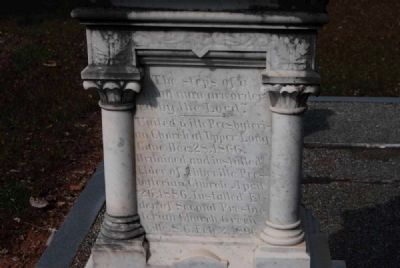
Photographed By Brian Scott, November 2, 2010
60. U.S. Rep. James Sproull Cothran
Tombstone - East Facing
Tombstone - East Facing
good man are ordered
by the Lord."
-----
United with Presbyterian
Church at Upper Long
Cane Dec. 28, 1866
Ordained and installed.
Elder of Abbeville
Presbyterian Church April
26, 1886. Installed
Elder of Second Presbyterian
Church Greenville,
S.C. Feb. 2, 1896.
— Submitted December 20, 2011, by Brian Scott of Anderson, South Carolina.
9. U.S. Senator Frank Boyd Gary
Born at Cokesbury, on the 9th of March, 1860. His early education was obtained in the Cokesbury Conference School. Afterwards entered Union College, Schenectady, New York, where he remained for three years, graduating, in 1881. Married Miss Maria Lee Evans, January 6th, 1897. He was elected to the House of Representatives, in 1890, serving continuously until 1901, but was not a candidate for re-election.
He held the position as speaker of the House, upon retiring; was also a member of the Constitutional Convention of 1895. He is trustee of the city schools of Abbeville, South Carolina. A member of the board of trustees that located and built Winthrop College at Rock Hill, South Carolina. He holds the position as high priest of Hesperian Chapter Number 17, Royal Arch Masons and past master of Clinton Lodge Number 3, Accepted Free Masons. Is also a member of Columbia Commandery Number 2, Knights Templars, and of Oasis Temple of Shriners, at Charlotte, North Carolina. (Source: Men of the Time - Schetches of Living Notables, A Biographical Encyclopedia of Contemporaneous South Carolina Leaders, by J.C. Garlington (1902), pgs 155-156.)
— Submitted December 20, 2011, by Brian Scott of Anderson, South Carolina.
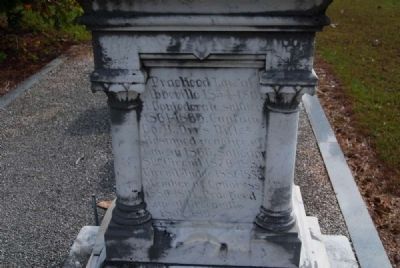
Photographed By Brian Scott, November 2, 2010
62. U.S. Rep. James Sproull Cothran
Tombstone - West Facing
Tombstone - West Facing
Abbeville 1854-1861.
A Confederate soldier
1861-1865. Captain
Co. B., Orr's Rifles.
Resumed practice of
Law in 1866. Solicitor
8th Circuit 1876-1881.
Member of Congress
1886-1891. Practiced
Law at Greenville
1891-1891.
Credits. This page was last revised on October 12, 2020. It was originally submitted on December 19, 2011, by Brian Scott of Anderson, South Carolina. This page has been viewed 4,140 times since then and 179 times this year. Photos: 1, 2, 3, 4. submitted on December 19, 2011, by Brian Scott of Anderson, South Carolina. 5. submitted on December 21, 2011, by Brian Scott of Anderson, South Carolina. 6, 7, 8, 9. submitted on December 19, 2011, by Brian Scott of Anderson, South Carolina. 10, 11, 12, 13. submitted on May 8, 2009, by Brian Scott of Anderson, South Carolina. 14, 15, 16. submitted on December 22, 2011, by Brian Scott of Anderson, South Carolina. 17. submitted on May 8, 2009, by Brian Scott of Anderson, South Carolina. 18. submitted on December 22, 2011, by Brian Scott of Anderson, South Carolina. 19, 20, 21, 22. submitted on March 11, 2011, by Brian Scott of Anderson, South Carolina. 23, 24, 25, 26, 27. submitted on December 19, 2011, by Brian Scott of Anderson, South Carolina. 28. submitted on March 11, 2011, by Brian Scott of Anderson, South Carolina. 29, 30, 31, 32. submitted on December 19, 2011, by Brian Scott of Anderson, South Carolina. 33, 34, 35, 36. submitted on March 11, 2011, by Brian Scott of Anderson, South Carolina. 37. submitted on December 19, 2011, by Brian Scott of Anderson, South Carolina. 38, 39. submitted on December 20, 2011, by Brian Scott of Anderson, South Carolina. 40, 41. submitted on March 12, 2011, by Brian Scott of Anderson, South Carolina. 42, 43, 44, 45. submitted on December 21, 2011, by Brian Scott of Anderson, South Carolina. 46. submitted on March 9, 2011, by Brian Scott of Anderson, South Carolina. 47, 48, 49, 50, 51, 52. submitted on December 21, 2011, by Brian Scott of Anderson, South Carolina. 53, 54, 55, 56, 57, 58. submitted on December 22, 2011, by Brian Scott of Anderson, South Carolina. 59, 60, 61, 62. submitted on March 15, 2011, by Brian Scott of Anderson, South Carolina.
